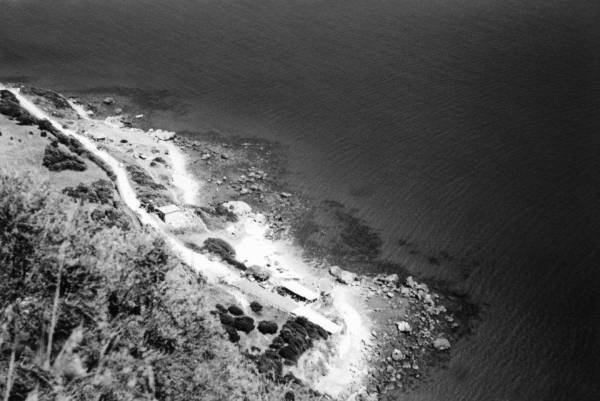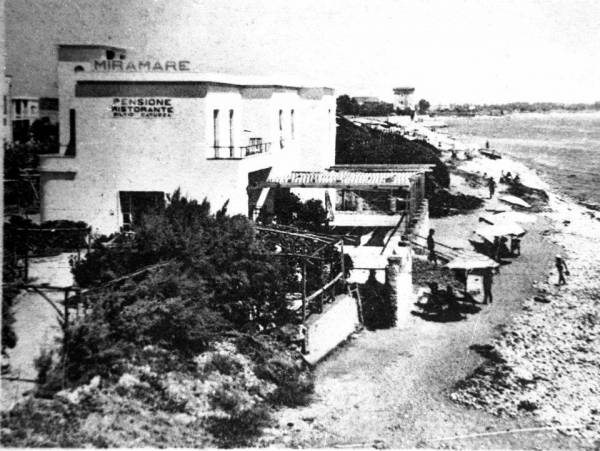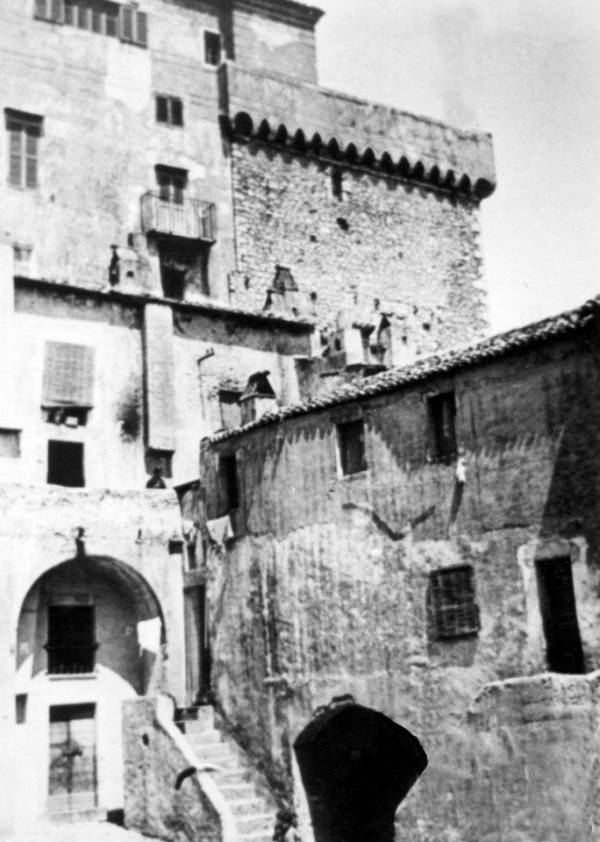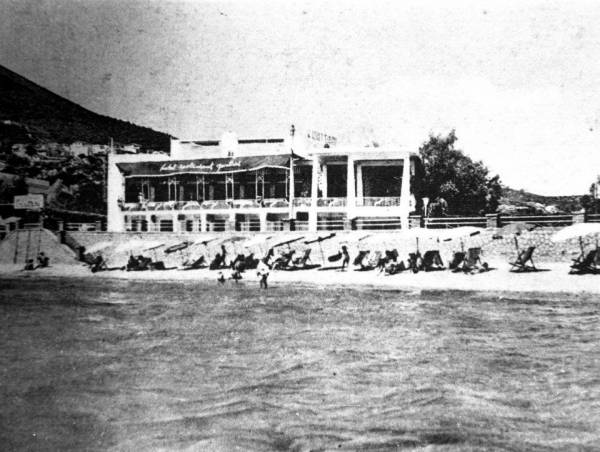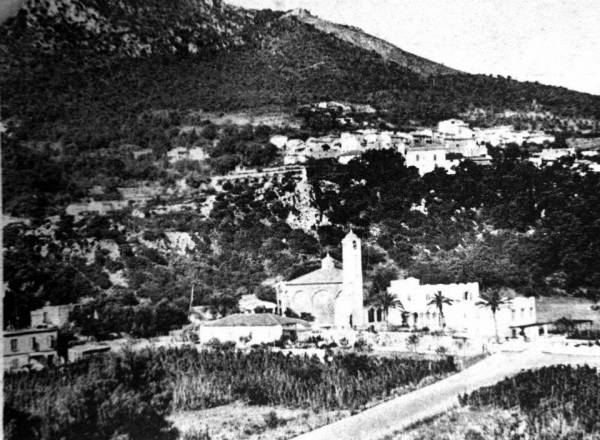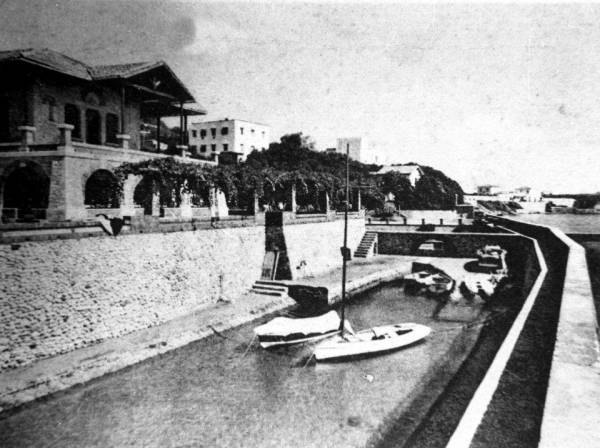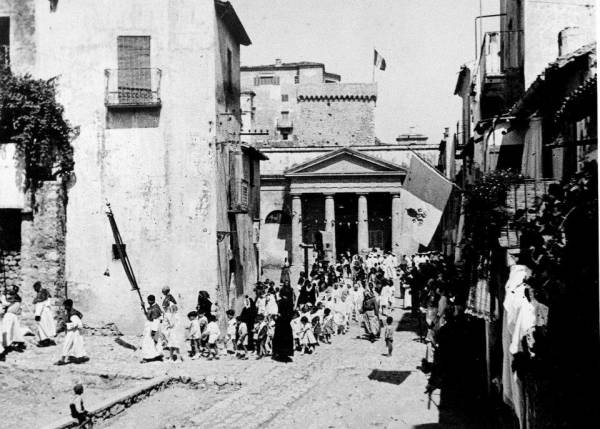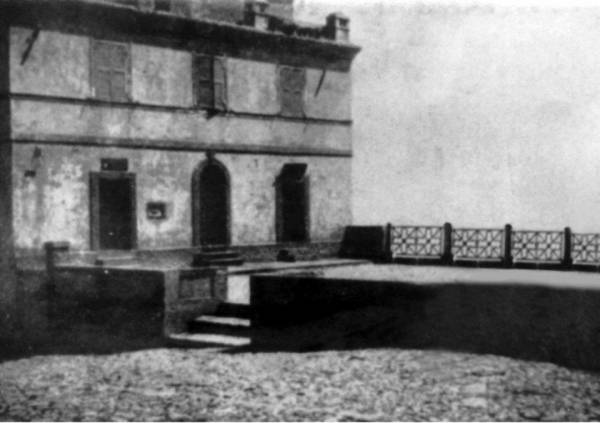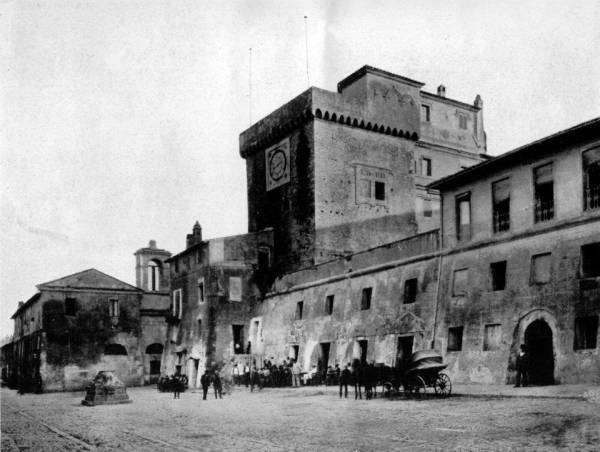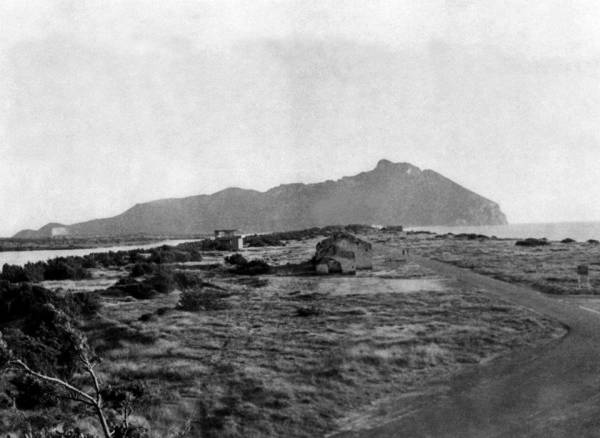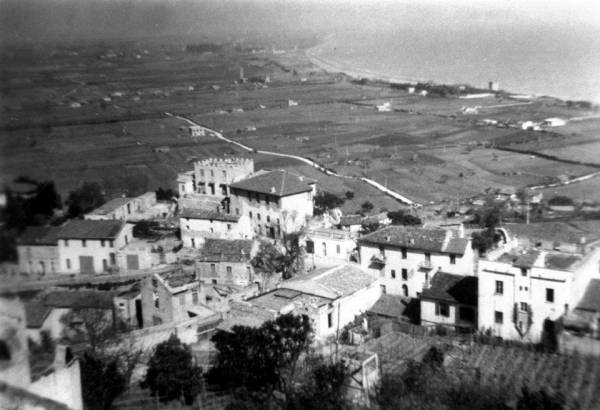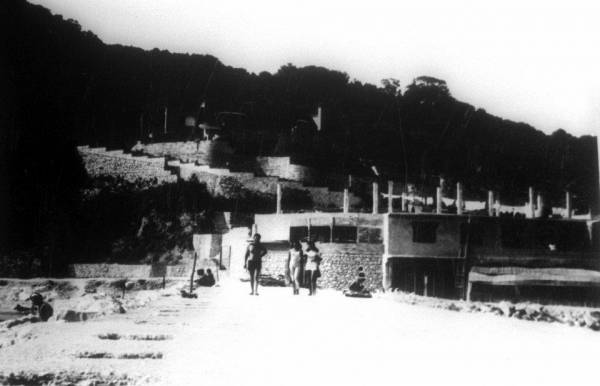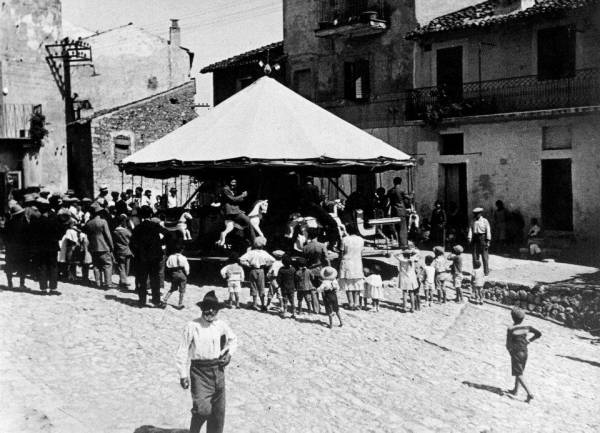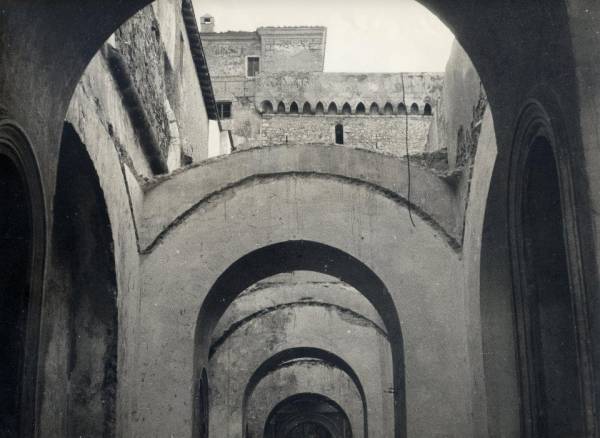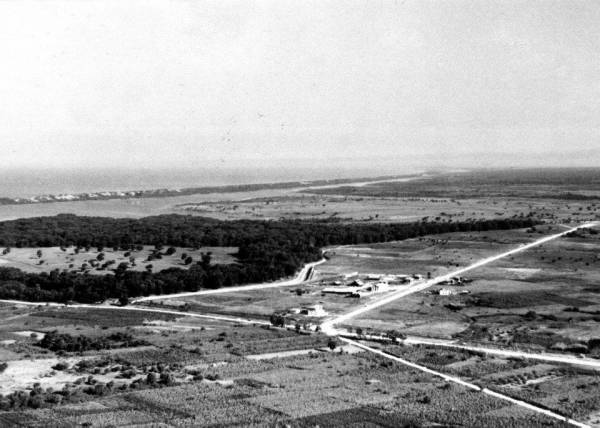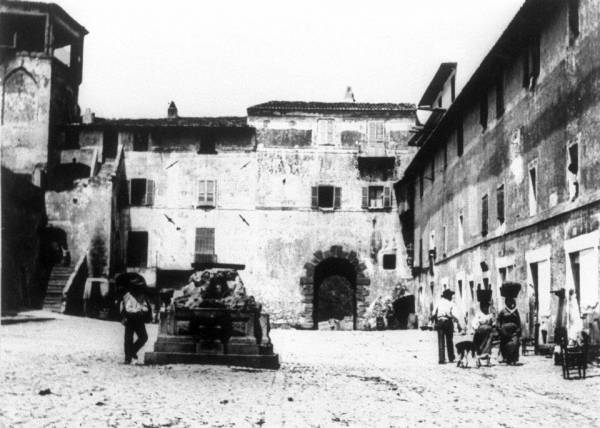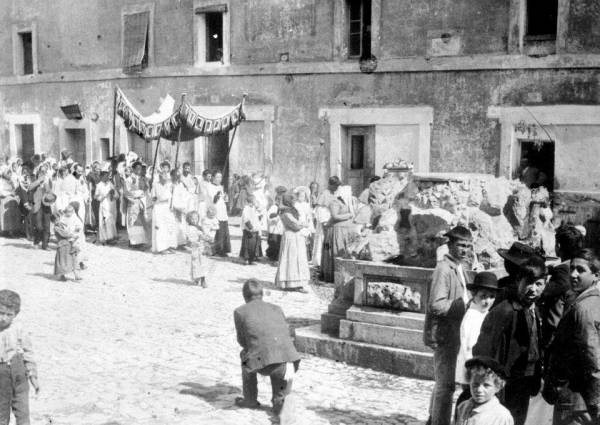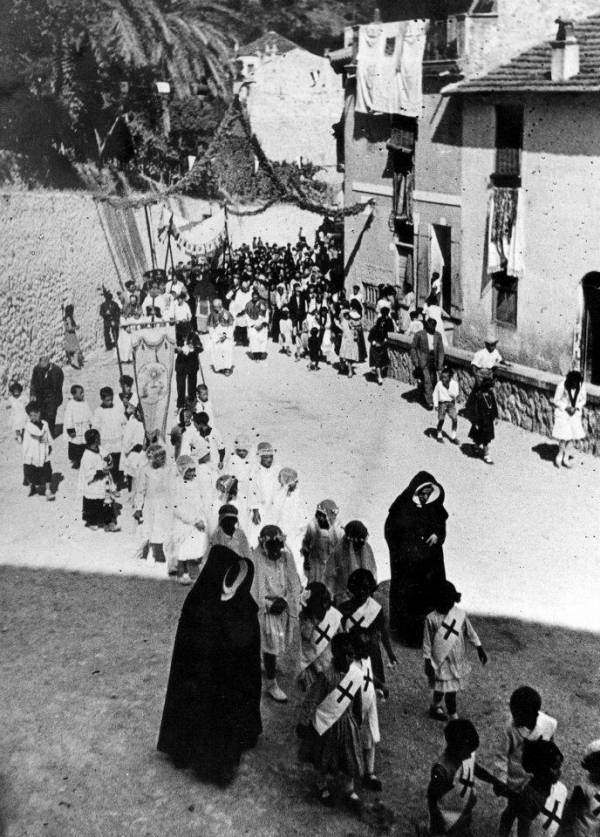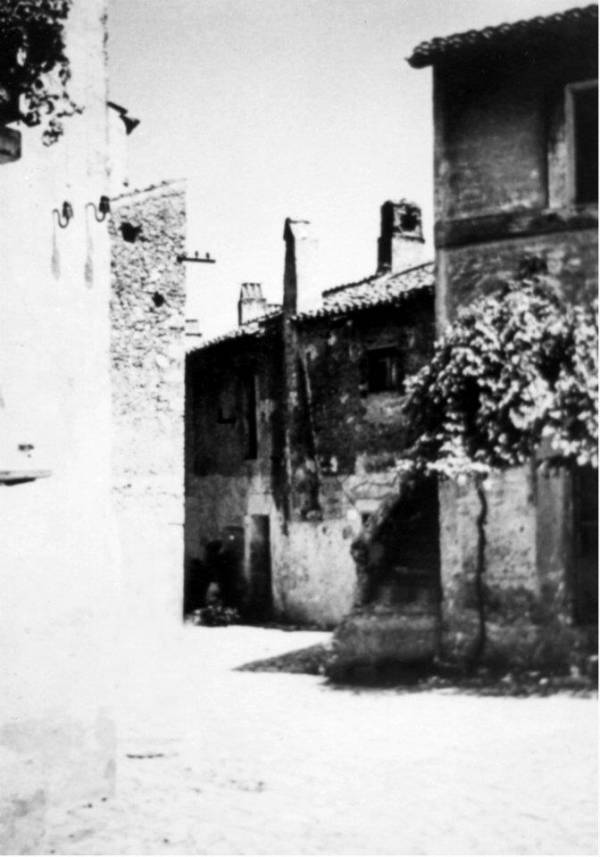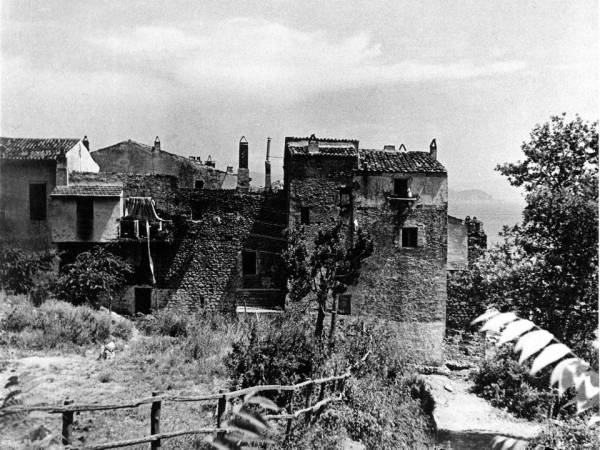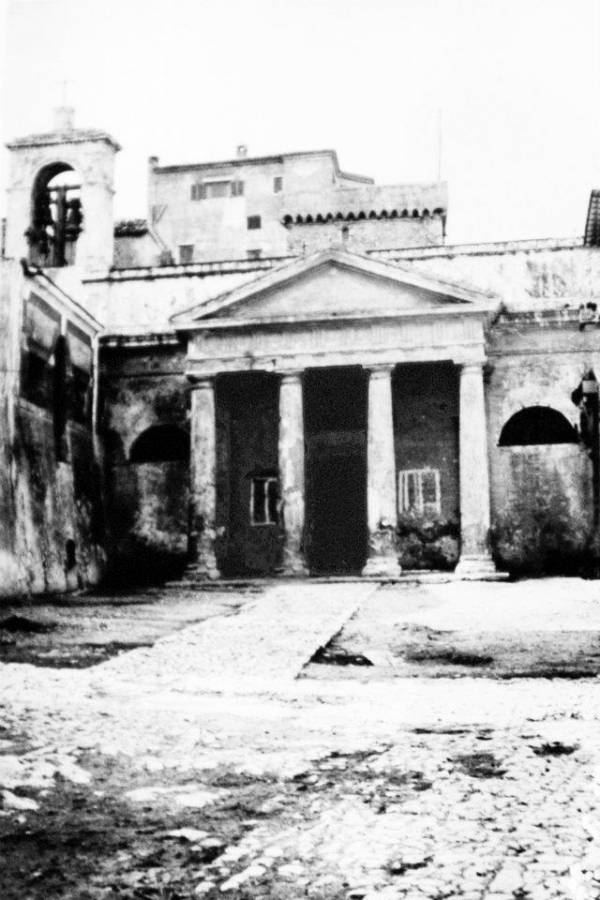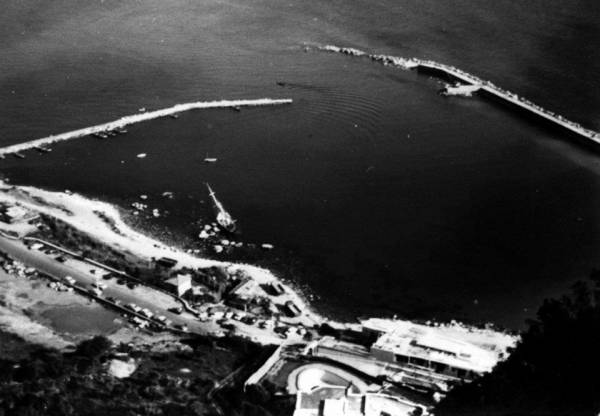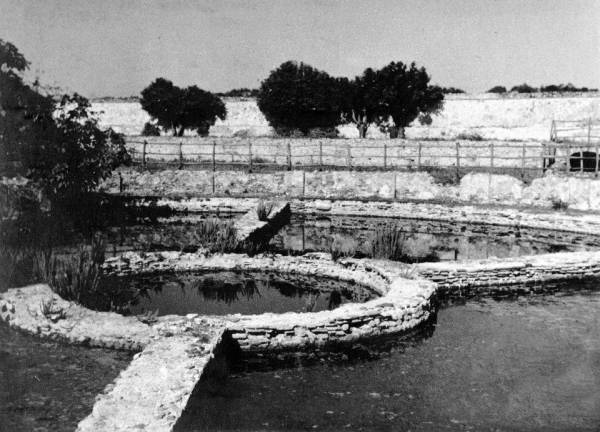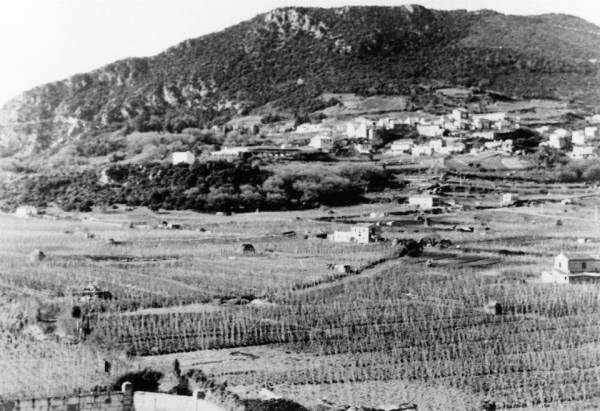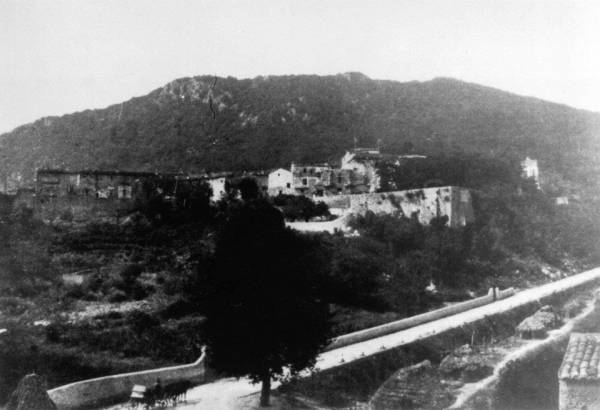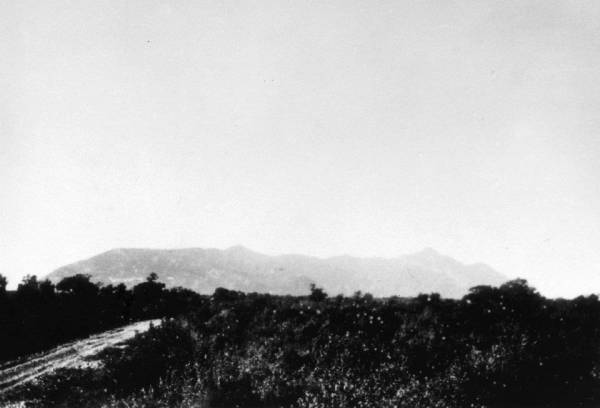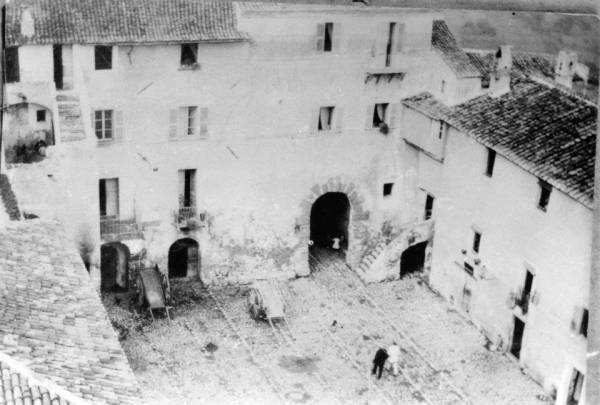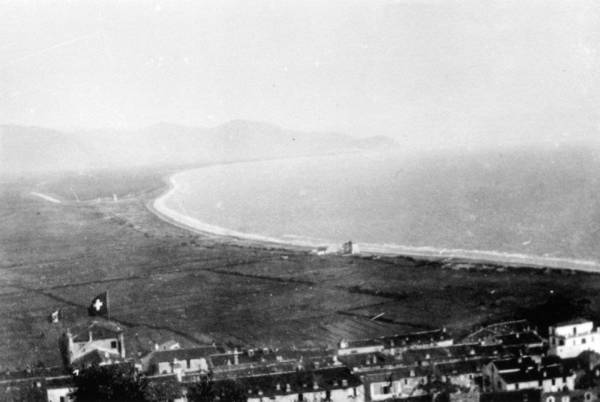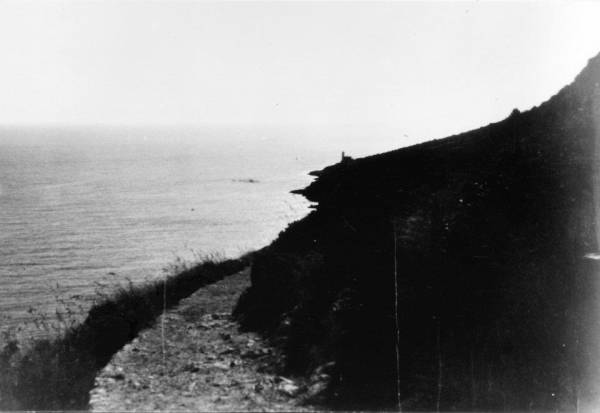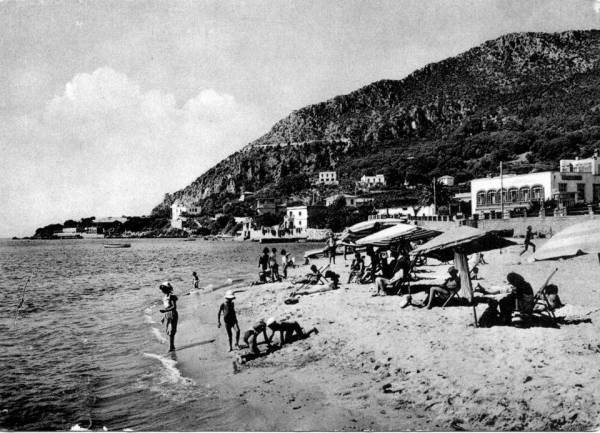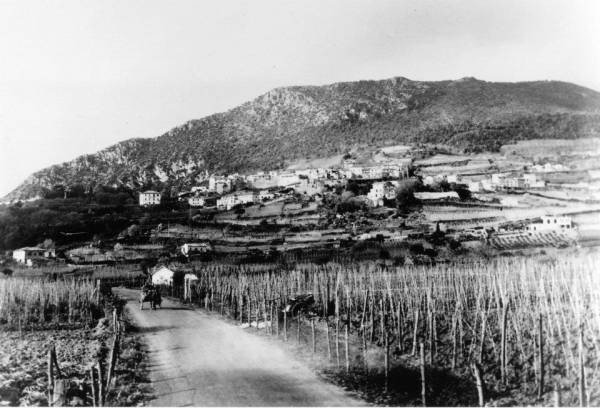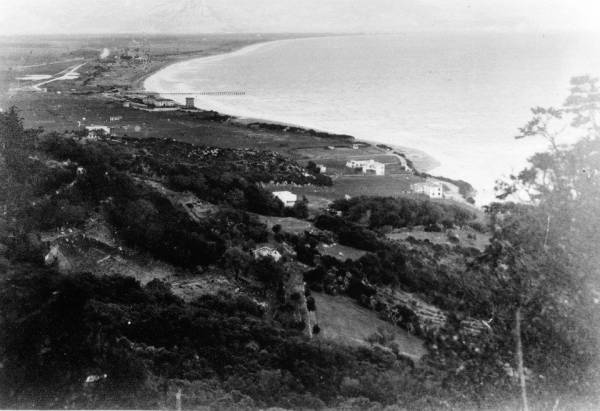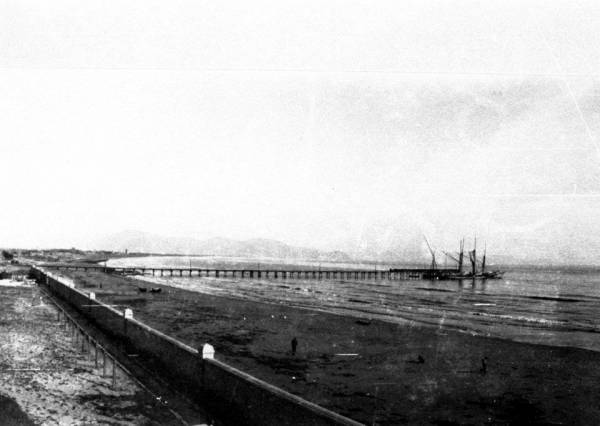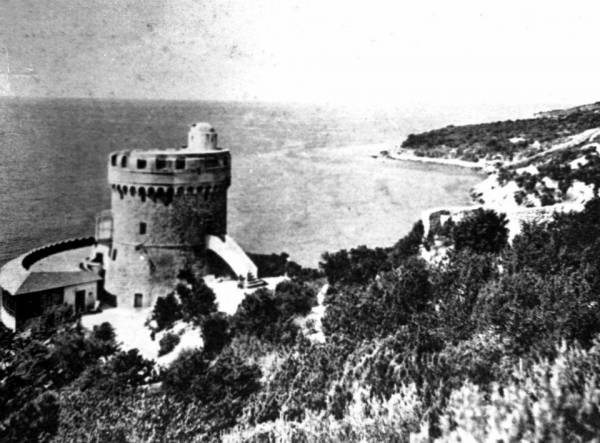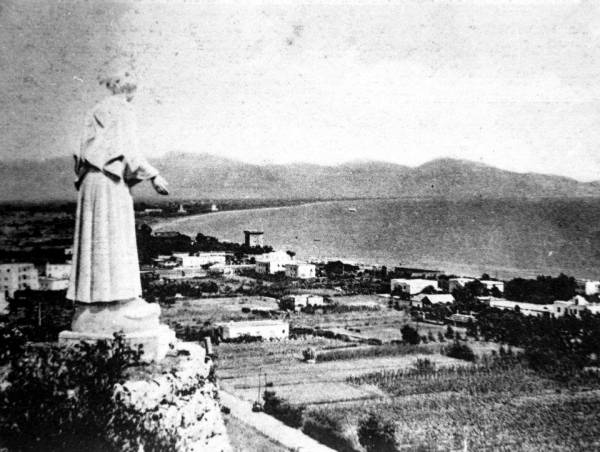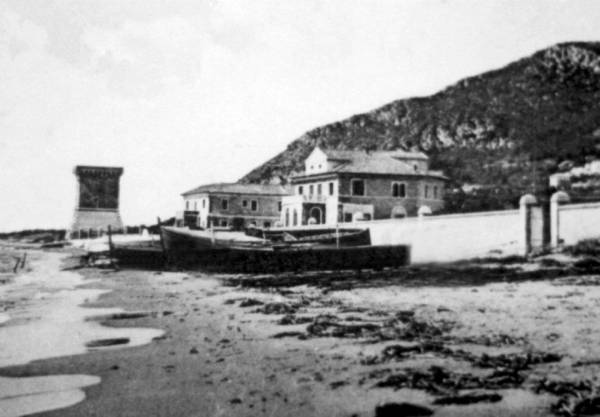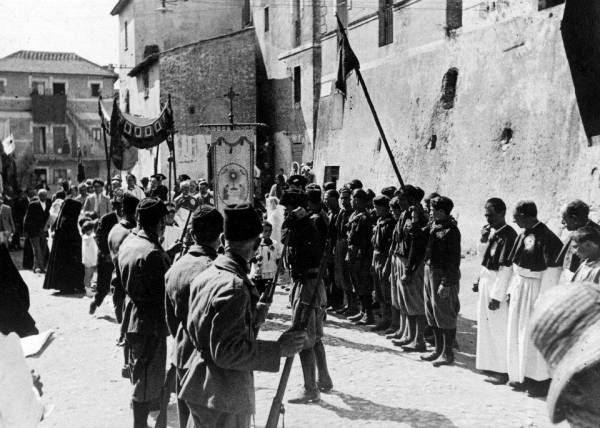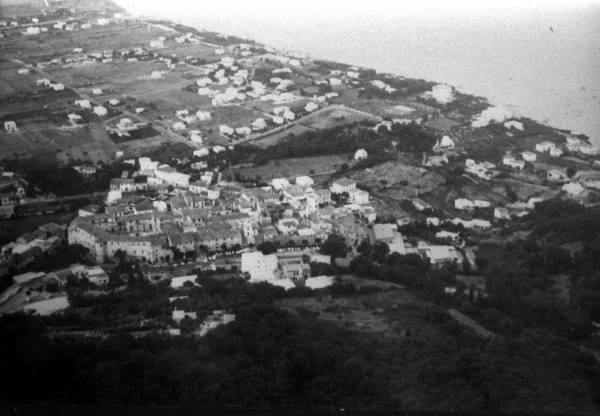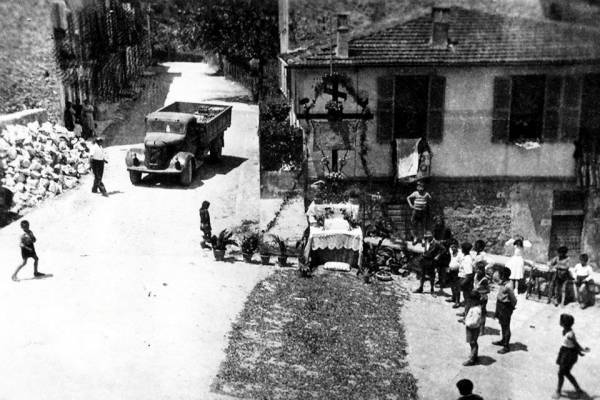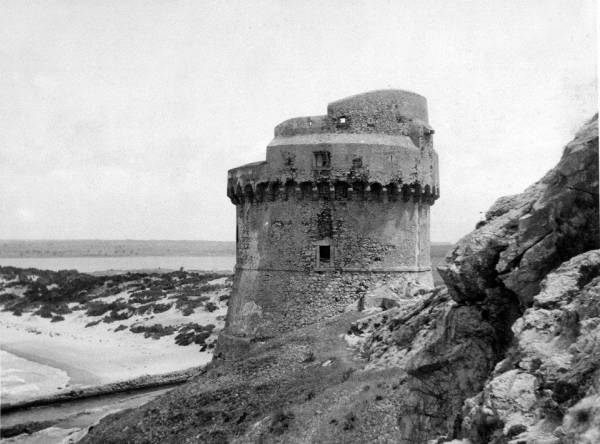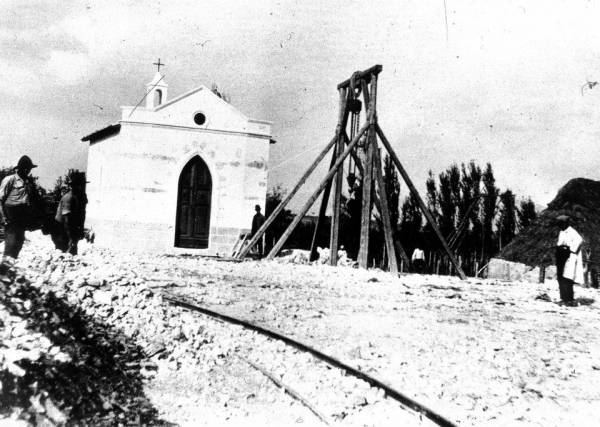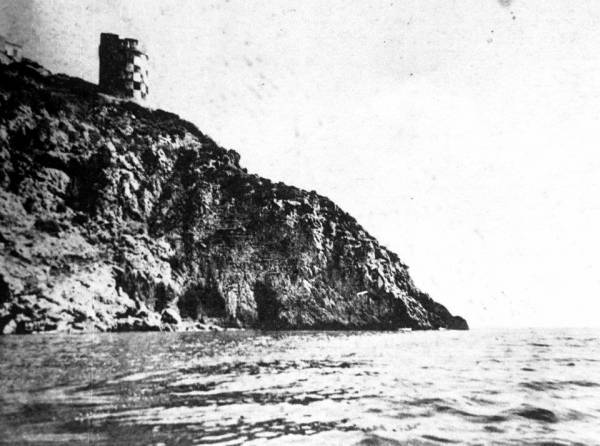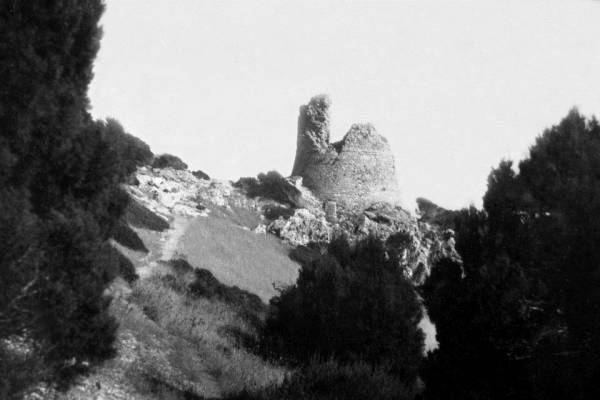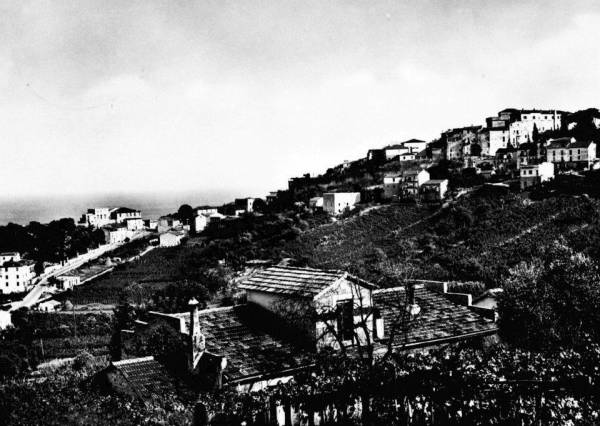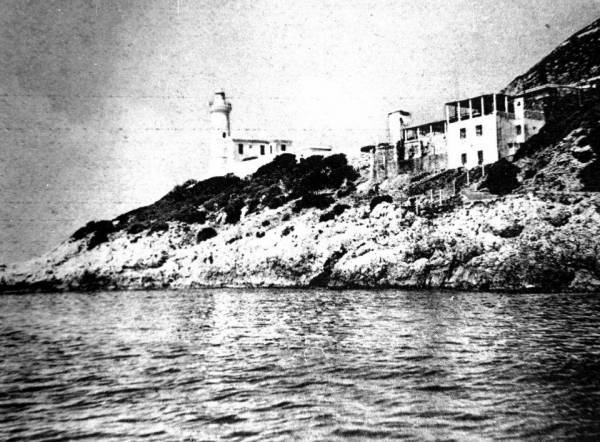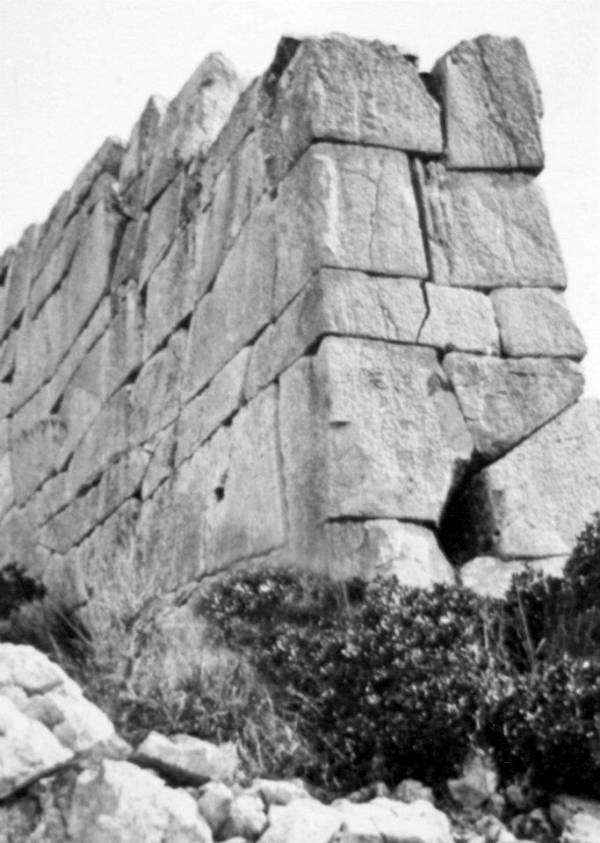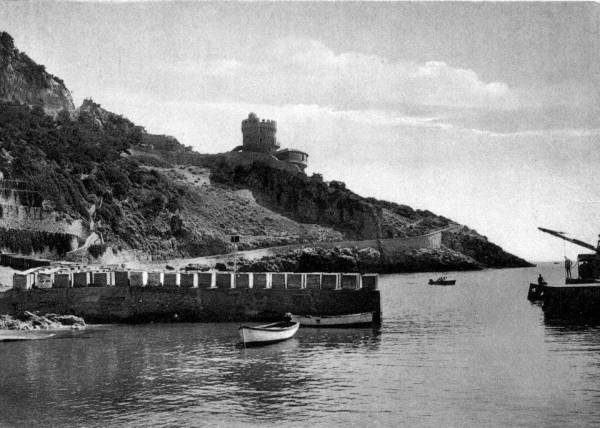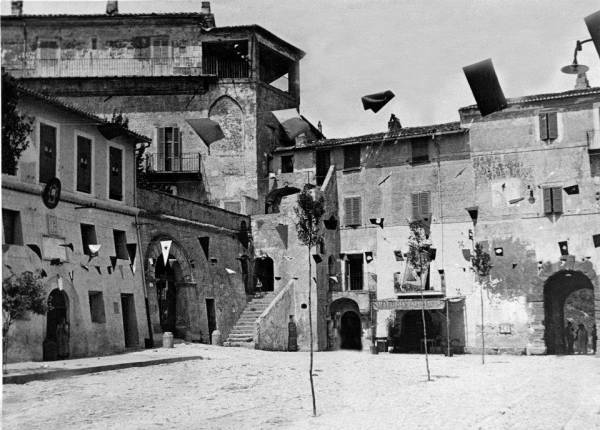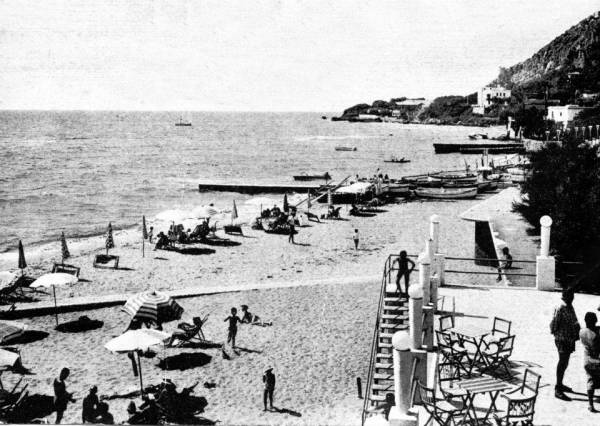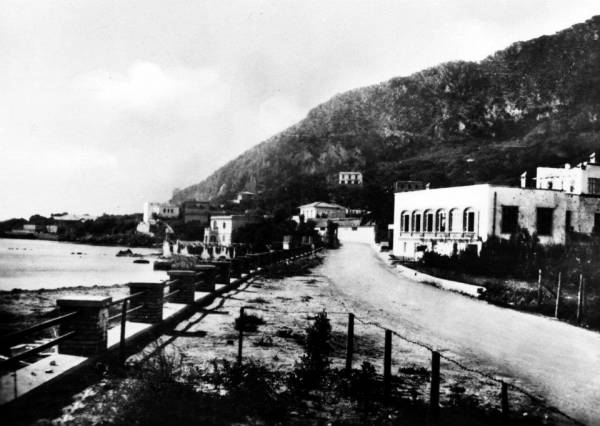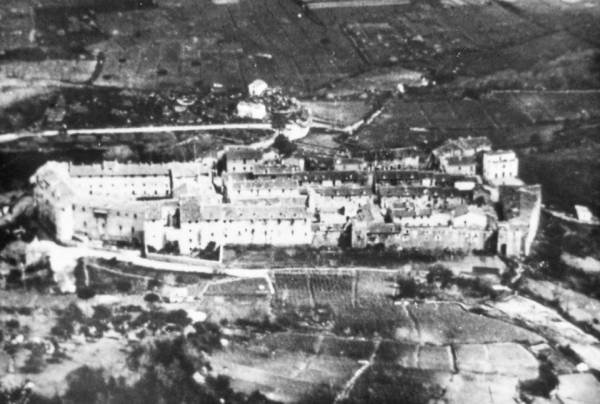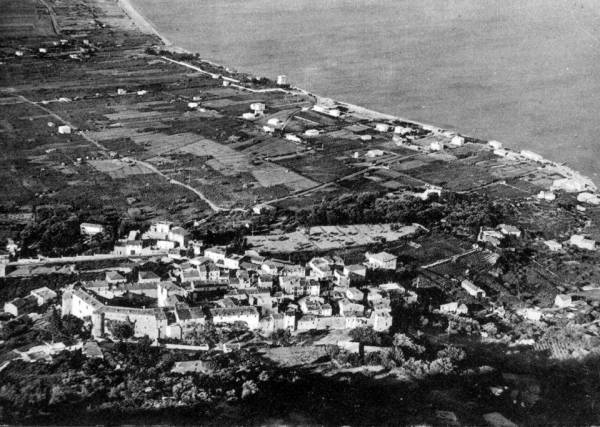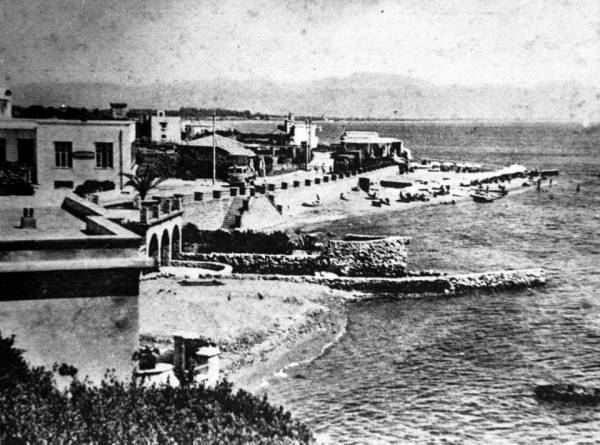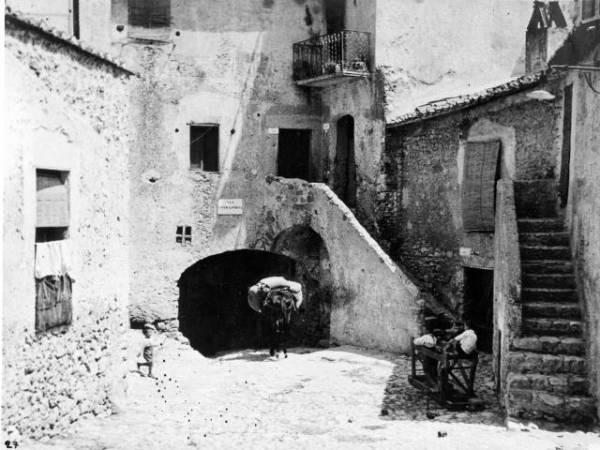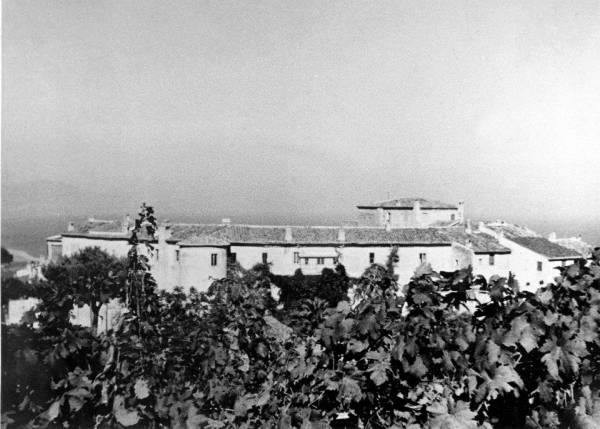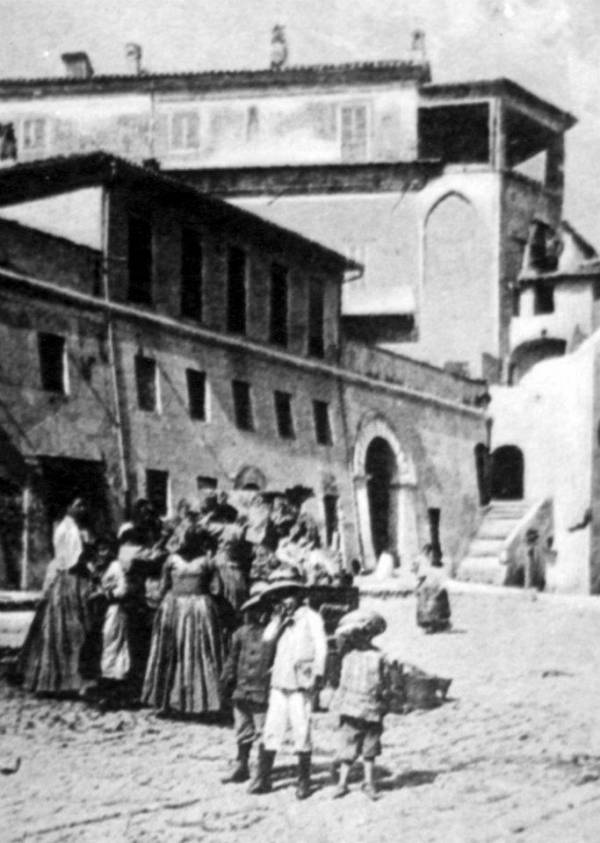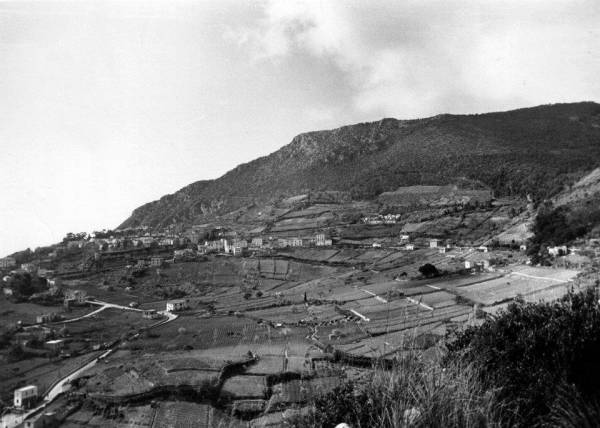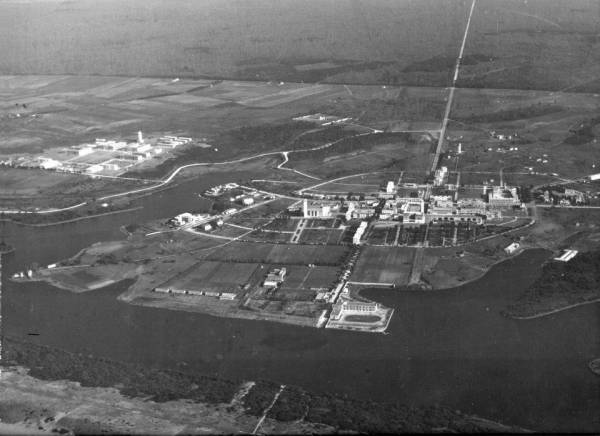Cenni sul Circeo
Circeo
Il monte Circeo (m.541), antica isola, s'innalza dall'incontro di due archi di costa pianeggiante, coi pendii precipiti avvolti da una pregiata macchia mediterranea. Il paese, ovvero il Centro Storico, è rivolto verso il Tirreno da un terrazzo del versante orientale del promontorio, ed è un luogo di vacanze balneari di ricercata eleganza. Storia, leggenda e mito si armonizzano perfettamente in questa piccola e antichissima località.
PREISTORIA
IL PALEANTROPO DEL MONTE CIRCEO
Nelle più che trenta grotte naturali litoranee che, a partire dal 1936, Alberto Carlo Blanc ha esplorato nel massiccio calcareo del monte Circeo egli ha constatato l'esistenza di giacimenti paleolitici riferibili a due culture preistoriche: una più antica di tipo musteriano per la quale egli ha proposto la denominazione di pon tiniana, una più recente di tipo aurignaziano medio, per la quale egli ha proposto la denominazione di circeiana.
Le grotte sono dovute a fenomeni di carsismo: le azioni dinamiche e chimiche del mare tirreniano hanno messo in rilievo ed ampliato le cavità costiere durante l'ultimo periodo interglaciale. Successivamente, e cioè nell'ultimo periodo glaciale, vi è stata una regressione marina fino a 100 metri circa sotto il livello marino attuale, sicchè le grotte son rimaste all'asciutto e ancora, nel periodo che dalla fine del periodo glaciale giunge fino a noi, il livello massimo è risalito fino allo zero attuale.
L'uomo ha assistito a questi grandiosi fenomeni naturali di trasformazione dell'ambiente biologico; senonchè, nella regione del Circeo, se si erano già da lungo tempo constatati i giacimenti paleolitici sopra ricordati, mancava il ritrovamento di fossili umani, finchè il 24 febbraio 1939 nella zona litoranea ai piedi di S. Felice Circeo e precisamente in un terreno adiacente all'albergo A. Guattari, in uno scasso di una cava di pietrisco, si rinvenne I'apertura di una antica grotta occlusa da decine di millenni per effetto di una frana caduta dall'alto del monte, e risultante di pietrisco che si era venuto via via cementando. In uno degli antri secondari di questa Grotta Guattari (che porta il n. 32 nella pianta Blanc delle grotte litoranee del Circeo) si rinvenne un teschio umano giacente tra alcune pietre disposte in circolo, insieme con ossa fossili di cervidi, suidi ed equidi. Il cranio, che ora è presso l'Istituto di Antropologia dell'Università di Roma, presenta i più tipici caratteri dei cosidetti uomini di Neanderthal (fronte sfuggente ed appiattita, accentuata platicefalia, ecc.). In relazione al calendario geologico basato sulle variazioni della radiazione solare, calcolato da M. Milankovitch, I'uomo del Circeo dovette appartenere ad un'età che si aggira sui 70.000 anni prima dell'era cristiana.
CIRCE ED ULISSE
La leggenda ha sin da antico tempo localizzato nel Circeo l'abitazione della maga Circe. Per Omero il Circeo è un'isola. Ulisse, salito su un'alta "vedetta di rupi" scorge nella sua interezza il contorno dell'isola
"e il pelago tutto d'intorno la stringe e ghirlanda" (OMERO, Odissea, canto X).
E proprio nel mezzo dell'isola, e in "un'aprica pianara", l'eroe vede alto levarsi un fumo fra dense boscaglie e fra selve.
E' la dimora di Circe "maestra di filtri" e al di là del palazzo di lucida pietra abitato da Circe, si vedono tutto in giro "ampie strade".
Ma il Circeo non è un'isola; è, fin dall'era terziaria, il promontorio di una penisola; e non vi si possono vedere "ampie strade".
Per conciliare i dati topografici omerici con la realtà del Circeo si è notato che coloro che, come i navigatori greci antichi, osservavano il Circeo da mare non solo vedevano il sole levarsi dietro il promontorio (Circe è " figlia del sole"), ma erano portati a ritenerlo un'isola, circondato com'è d'ogni lato da lagane e paludi e così pure potevano ritenerlo un'isola coloro che l'osservavano dalla terraferma, avuto riguardo alle paludi e al mare che lo chiudono. Ai limiti della palude sono talora veri boschi di querce e folti macchioni, che hanno, in qualche caso, straordinario rigoglio; e tra questi macchioni sarebbe stato il palazzo di Circe.
STORIA
IL CIRCEO IN ETA' STORICA - Circeii fu in tempo assai antico al pari di Cuma, centro di commerci e di cultura ellenica (E. Pais).
Furono i navigatori greci che localizzarono qui il mito omerico di Circe; e tuttavia, secondo un'opinione autorevolmente sostenuta, il nome Circeii non deriva dal nome della maga Circe, ma dalI'aspetto rotondo del promontorio (in latino = circus; in italiano = cerchio, circolo).
Là dove è oggi San Felice, a m. 98 sul mare, sorse una piccola città detta Circeii, che divenne uno dei capisaldi dei Volsci quando questo popolo che, secondo taluni, è originario dell'Illiria, si spinse dalle più recenti sedi umbre verso il Tirreno, sulla fine del secolo VI o agli inizi del secolo V a. C.
A Circeii i Romani dedussero nel 393 a. C. una colonia di diritto latino, la quale, insieme con altre undici colonie, pure di diritto latino, fu tra le poche che rifiutarono aiuti a Roma in occasione della guerra annibalica. Il diritto della cittadinanza Circeii lo acquistà solo al tempo della guerra sociale.
L'esistenza di talune costruzioni di età imperiale sulla costa occidentale del promontorio del Circeo, nella località "Palazzo" non lungi dalla Torre Paola (e cioè sul lago già detto di Paola, ora di Sabaudia) ha fatto ritenere a chiari studiosi - tra cui il Beloch, il De la Blanch re e Th. Ashby - che sulla fine dell'età repubblicana di Roma, o, al più tardi, al principio dell'impero, la città di Circeii si sia trasferita col suo nucleo più notevole presso il lago di Paola.
L'opinione deve considerarsi erronea. E' verosimile che con i lavori della Fossa Augusta intrapresi da Nerone per unire il lago di Averno ad Ostia per mezzo di un canale navigabile entro terra (TAC., Ann., XV, 42), e con la costruzione delle sponde in muratura di un canale di comunicazione tra l'odierno lago di Sabaudia e il mare, si sia determinato nella regione un maggiore movimento commerciale e una connessa maggiore attività edilizia. D'altra parte sul lago di Sabaudia sono le rovine della villa che Domiziano, amante dei paesaggi appartati e un po' selvaggi, si fece qui costruire. E' stata l'esistenza di queste strutture murarie domizianee - prima non identificate come pertinenti ad una villa - a far ritenere agli studiosi che Circeii sia stata trasferita in età imperiale sul lago di Paola.
LA CITTA' - Dell'abitato di Circeii a S. Felice non ci sono giunti che alcuni tratti delle mura poligonali e pochi muri interni in opera reticolata. La città ha pianta grossolanamente rettangolare, ed è attraversata nel senso del decumano dalla sua via principale d'accesso, che viene da Terracina (la Via Severiana).
Il lato meglio conservato delle mura è quello di sud-est, e in esso il tipo del poligonale risulta di blocchi non squadrati nè levigati: tra gl'interstizi, talora assai larghi, sono inserite scaglie di risulta. Lo spessore di queste mura raggiunge talora i 3 metri; le case moderne sovrapposte alle mura hanno rispettato il tracciato antico.
ACROPOLI - Ben più notevole degli avanzi di mura della città sono gli avanzi delle mura dell'acropoli. L'acropoli sorgeva su uno sperone di monte a circa 300 metri di altezza sul mare, e si data, come del resto la murazione urbana a S. Felice, dall'età della deduzione della colonia di diritto latino (a. 393 a. C.). L'acropoli stessa ha approssimativamente la forma di un quadrilatero che angoli e smussi determinati dall'andamento della roccia rendono assai irregolare. Le dimensioni approssimative sono di m. 190 X 95.
L'opera poligonale è, nel suo insieme, assai notevole. I blocchi giungono talora a m. 2,78 di lunghezza in fronte; in qualche punto il muro urbano giunge a m. 5,60 di altezza nella parte esterna, e a m. 4,35 dal lato interno; lo spessore cresce via via con lo scendere della muraglia verso il basso; in un punto che rimane a 3 metri sotto il coronamento (che non è però l'originario) tale spessore è di m. 2,33.
In fronte, dal lato esterno, l'opera poligonale risulta di blocchi bene squadrati, ben levigati e bene uniti sui margini, anche quando la giunzione sia obliqua, o un blocco si incassi in un altro per uno spigolo. Dal lato interno, al contrario, i blocchi sono senza alcuna rifinitura nei contorni, ed hanno le dimensioni più diverse, presentando così quell'aspetto che solitamente vien detto "ciclopico", è da escludere ovviamente che l'opera appartenga a due periodi diversi, sicchè anche il lato interno è da riportare all'età della deduzione della colonia. Tra le due cortine il riempimento è fatto con scaglie di risulta.
L'acropoli non era abitata: essa serviva unicamente da luogo di difesa in occasione di pericolo;
Nel punto più alto del monte, su una spianata artificiale, son talune vestigia appartenenti con tutta probabilità a un tempio dedicato a Venere o alla dea Circe identificata con Venere vi fu trovata la testa della dea ivi venerata e un'ara dedicata a Circe santissima.
La testa è ora nel Museo Nazionale delle Terme.
VILLA DI DOMIZIANO SUL LAGO DI PAOLA - Particolarmente notevoli sono le rovine di una villa fastosa che è stata dal Lugli assegnata, in ragione soprattutto del tipo delle strutture murarie, e per taluni accenni di Marziale, all'imperatore Domiziano (81-96 d. C.). Nel 1934, col contributo dell'Opera Nazionale Combattenti e poi del Comune di Sabaudia, vi sono stati condotti fruttuosi scavi diretti da G. Jacopi. Tra i ruderi attiravano già l'attenzione, in modo particolare, uno stabilimento termale con tre grandi esedre, due bei colonnati, alcune grandiose cisterne, un piccolo ninfeo sul lago, e altre strutture; con gli scavi Jacopi si è messo in luce, fra I'altro, un quadriportico pavimentato in opus spicatum marmoreo policromo, "esempio forse unico del genere", e sono stati scoperti anche alcuni pregevoli affreschi parietali a sfondo architettonico, e con figure, di piccole e di grandi dimensioni.
Dalla villa si sono altresì già da tempo recuperate sculture in gran numero, di cui una veramente insigne, e cioè l'Apollo detto di Cassel, che è una replica da un originale famoso, pel quale si è fatto anche il nome di Fidia. In occasione degli scavi Petrini del 1798 si rinvennero altre ventinove tra statue e frammenti di statue, e, tra esse, la statua del satiro col flauto traverso, oggi nel Braccio Nuovo del Museo Vaticano. Alcune sculture, pure provenienti dal lago di Paola, si trovano ora nel Museo Civico di Terracina, dove è altresi un'iscrizione della stessa provenienza, che ricorda un Lucio Faberio Murena, quatuorviro ed edile, che costruì un vivaio per pesci presso il lago di Paola, utilizzando, per la cultura del vivaio, I'alternanza dell'alta e della bassa marea.
Non è improbabile che sia appunto di Faberio Murena quella singolare piscina che è detta volgarmente "piscina di Lucullo", che non fa parte dei monumenti della villa imperiale.
Tra il Ponte Papale (di Innocenzo XIII, del 1721) e la Casa dei Pescatori son da ricordare anche i resti del canale in muratura costruito per porre in comunicazione col mare la Fossa Augusta neroniana.
Infine è da tener presente che al piede settentrionale del promontorio del Circeo, fra Torre Vittoria e Torre Paola correva la Via Severiana che, provenendo da Terracina, proseguiva per Torre Astura e per Anzio.
S. FELICE CIRCEO - Sulla rocca di S. Felice Circeo, fra le più forti e sicure dello Stato Ecclesiastico, manchiamo quasi completamente di notizie storiche per il periodo anteriore al 1100, all'infuori di scarsi accenni sulle gravi distruzioni subite da parte dei Goti di Alarico nel 410 sappiamo inoltre che nel 546 fu conquistata da Totila, re degli Ostrogoti e nell'846 nuovamente distrutta dai Saraceni. Nel 1118 il pontefice Gelasio II ordina la restituzione del castello ai Terracinesi, i quali dovevano averlo quindi in custodia prima che fosse affidato da Pasquale II (1099-1118) al cardinale Ugo di Alatri. Quando i Frangipane s'impadronirono di Terracina, essi occuparono anche il Castello di S. Felice che nel 1203 ritornò in potere dei Terracinesi dopo che questi si furono liberati dal servaggio imposto dai Frangipane. Consegnata per ordine di papa Innocenzo III a Pietro Annibaldo, suo nipote per parte di sorella, nel 1207 la Rocca fu affidata di nuovo ai Terracinesi, i quali giurarono di difenderla e mantenerla a favore della famiglia Frangipane.
Da una pergamena conservata nell'archivio della Casa Caetani risulta che nell'anno 1259 i Cavalieri Templari del convento di S. Maria Aventino di Roma avevano il pieno dominio nella terra di S. Felice, con torre, case, vigne, territorio: dominio che cedettero al nobile di Terracina Giordano Vicecancelliere e Notaro di S. Chiesa, che era della famiglia Pironti, diramata da quella dei Conti.
Il 3 febbraio 1270 gli uomini del Castello di S. Felice giurarono sui vangeli perpetua fedeltà alla città di Terracina di cui ottennero la cittadinanza.
Dai Pironti passata agli Annibaldeschi, potente famiglia romana nel 1301 Riccardo degli Annibaldeschi vendette il Castello di S. Felice colla sua Rocca, vassalli, territorio col mero e misto imperio e il Lago di Paola a Pietro Caetani, nipote di Bonifacio Vlll. Da quell'epoca la famiglia Caetani continuò ad esserne padrona per più di quattro secoli, sebbene varie volte l'abbia perduta o ne fosse spogliata nelle vicende delle lotte fra le potenti famiglie romane. Per breve tempo ceduta a re Roberto di Napoli, nel 1332 dai Caetani di Sermoneta passò ai Caetani conti di Fondi.
Nel 1403 la comunità di S. Felice, data l'esiguità del suo territorio, ottenne da papa Bonifacio IX l'uso di seminare una porzione del territorio di Terracina. Nel 1941 Alfonso d'Aragona in lotta con Eugenio IV entrò nello Stato della Chiesa, e dopo essersi impadronito di Terracina, assalì il Castello di S. Felice, lo spianò e distrusse interamente e costrinse parte degli abitanti a trasferirsi a Terracina. Occupato dalle forze di papa Pio II, i Caetani ebbero restituito il Castello da Niccolò V, eccettuato il sito dove una volta stava la fortezza, riservata in potere della Santa Sede, con espressa proibizione ai Caetani di edificarne un'altra senza il permesso della Santa Sede stessa.
Acquistato da papa Alessandro VI per la figlia Lucrezia Borgia, il Castello, che nel 1501 ebbe a subire nuove e vaste devastazioni dalle milizie di Federico di Napoli, ritornò ai Caetani nel 1506 con facoltà di ricostruire la fortezza. Nel 1562 Pio IV ordinò al cardinale Niccolò Caetani che fabbricasse a proprie spese quattro torri intorno al monte, a condizione che il loro armamento, le munizioni ed il presidio militare fossero a spese della Camera Apostolica.
Successivamente, per vendita o baratto il feudo passò ai Ruspoli ed agli Orsini, ritornando nel 1720 alla Camera Apostolica. Questa, nel 1808, per sopperire alle spese che doveva affrontare per la fornitura dell'armata francese, fu obbligata a venderlo a Sua Altezza il Principe Stanislao Poniatowski per il prezzo di scudi 86.000. Ma anche il Poniatowski, il quale aveva fatto molti miglioramenti nel palazzo baronale e nel palazzino di Paola, nel 1822 dovette restituire la terra di S. Felice alla Camera Apostolica alla quale rimase fino al 1870, quando divenne patrimonio dello stato italiano che successivamente l'alienò.
Durante il medio evo e fino alle soglie dell'età contemporanea, il Castello di S. Felice e le torri che lo circondavano ebbero importanza soprattutto per la difesa di quel tratto di costa e del mare prospiciente dalle incursioni dei pirati barbareschi. Infatti, ancora nel 1727, pirati tunisini, sbarcati all'improvviso, portarono in schiavitù 25 persone del Castello di S. Felice. Ma ben altra era la preda alla quale miravano. Lo sbarco avvenne il 3 maggio: il giorno precedente papa Benedetto XIII, in viaggio lungo la costa da Roma a Terracina, si era imbarcato di buon mattino a Torre Paola su una feluca pontificia, sfuggendo così, per puro miracolo, alla cattura.
S. Felice, data la sua funzione esclusivamente strategica, posta in un punto isolato del Lazio, segregata dal resto della regione da paludi e da boscaglie intransitabili, manca completamente di ogni manifestazione artistica.
Di qualche interesse è la Torre dei Templari che sorge sulla piazza principale della città. Ha la pianta quadrata caratteristica delle torri di quell'Ordine. La finestra a croce in parte occlusa, che si trova sulla facciata di levante è stata aperta evidentemente alla fine del '400. Annessa alla Torre e con essa comunicante era la Casa dei Cavalieri, la cui facciata presenta nel primo piano una serie di archi a tutto sesto presentemente chiusi per ricavarvi ambienti di abitazione.
Notevoli le torri in parte quadrate, in parte rotonde, che orlano il promontorio lungo il mare. Esse sono state costruite nei secoli XV e XVI per avvistare soprattutto legni di corsari barbareschi che infestavano le spiagge del medio e basso Tirreno.
Interessante la bella Torre rotonda di Paola, la quale ancora nella prima metà del secolo scorso venne fornita di nuove artiglierie.
IL CENTRO STORICO
A 100 metri sul livello del mare, sul versante chiamato "Quarto Temperato", sorge il borgo medievale di San Felice Circeo; nonostante l'aspetto medievale il paese ha origini romane, come testimonia la pianta del paese con reticolato a cardini e decumani.
I vicoli del paese, che si aprono su particolari piazzette e caratteristici scorci panoramici, brulicano di vita durante la bella stagione.
Passeggiando lungo le strade del paese, colpisce l'attenzione del visitatore il giardino pubblico e belvedere "Vigna la Corte", uno tra i più bei punti di osservazione del litorale pontino. Alle spalle della piazza principale ( Vittorio Veneto) sorge il palazzo baronale, che per ben quattrocento anni è stato dimora dei Caetani, mentre deve al principe Ponyatowsky il rifacimento dell'ultimo piano e l'aspetto attuale.
Sulla stessa piazza L. Lanzuisi, si affaccia la Torre dei Templari che ospita ormai da tempo la Mostra permanente dell'Homo Sapiens ed Habitat.
La Torre dei Templari, in pieno Centro Storico, ospita la Mostra Permanente dell'Homo Sapiens ed Habitat, istituita nel 1978 per volontà del prof. Marcello Zei.
La mostra comprende quarantasette espositori didattici, nei quali sono illustrati i più significativi eventi dell'Era Quaternaria, con particolare attenzione al territorio Pontino ed al Circeo.
Il Museo è aperto al pubblico solamente nella stagione estiva, sono previste aperture straordinarie per le scolaresche e grandi gruppi.
Dalla vicina piazzetta G. Marconi, belvedere sul mare fino all'arcipelago Ponziano, e sulla Pianura Pontina.
All'acropoli di "Circeii" (m. 300), km 2,5 dalla porta d'ingresso del paese salendo a destra: sul panoramico piazzale sono ancora visibili i resti di antiche mura poligonali, con due cortine di blocchi ben squadrati verso l'esterno.
Le mura Ciclopiche risalgono al IV secolo a.C., hanno un perimetro di circa due ettari e costituivano la cinta muraria dell'antica Acropoli di Circeii. Le mura, realizzate in opera poligonale, sono composte da enormi blocchi di pietra calcarea, perfettamente lisce nella parte esterna, rendendole così meno vulnerabili alle incursioni, ma completamente grezze dall'altro lato. All'interno dell'area è ancora presente una grotta ipogea, una cavità a forma di cono che si estende nel sottosuolo, probabilmente un antico pozzo.
Grazie alla sua collocazione a circa 300 metri sul livello del mare, la visita all'Acropoli permette di ammirare uno splendido panorama su tutta la pianura sottostante con i laghi costieri, la foresta, il mare e le isole pontine.
GROTTE
Alla grotta delle Capre, km 2,5 a sud-ovest, seguendo la strada del Faro, poi via Grotta delle Capre: è la più nota tra le numerose grotte che si aprono alla base del Circeo.
Sulla spiaggia, entro il recinto dell'albergo Neanderthal, si trova la grotta Guattari o di Neanderthal, in cui è stato rinvenuto il teschio umano contemporaneo dell'uomo di Neanderthal.
TORRI PAPALI
Al faro di torre Cervia, km 3 a sud-ovest per strada panoramica che, tra giardini e ville, corre alta sul mare lungo il versante meridionale del promontorio.
Fu costruito nel 1866 per volontà di Papa Pio IX, rimanendo a lungo l'unica costruzione della zona. La parte adiacente alla struttura è abitata dal custode civile del Faro, sebbene sia sotto l'amministrazione della Marina Militare Italiana
Alla torre Paola, km 7 a nord-ovest, all'estremità occidentale del promontorio del Circeo. Con accesso dalla litoranea di Sabaudia, è una torre di guardia eretta da Paolo III nel sec. XVI presso l'emissario del lago di Sabaudia. Nei pressi, poco più a sud, la grotta della maga Circe, cui si accede solo via mare.
IL PARCO NAZIONALE DEL CIRCEO
Il Parco Nazionale del Circeo, istituito nel 1934, attualmente ha un'estensione di circa 8.500ha e comprende zone diversamente caratterizzate fra di loro.
La Selva di Circe
La Selva di Circe rappresenta la più estesa foresta naturale di pianura presente in Italia.
Si estende per 3.300 ha circa, mantenendo alcune delle peculiarità dell'antica foresta, la Selva di Terracina, che, prima della bonifica degli anni trenta, ricopriva oltre 11.000 ha.
La foresta oggi è ancora un ecosistema ricchissimo ed estremamente vario.
Caratteristiche, ad esempio, sono le "Piscine", aree paludose che si formano spontaneamente per accumulo di acqua piovana ed affioramento della falda e le "Lestre", zone su cui un tempo gli abitanti stagionali edificavano i loro precari villaggi.
Nella foresta esistono tre aree di Riserva Naturale Integrale: la Piscina delle Bagnature, la Piscina della Gattuccia e la Lestra della Coscia.
Tutta la foresta è visitabile tramite una rete di sentieri sia pedonali che ciclabili.
Percorrendoli, nello spazio di una passeggiata, s'incontrano specie vegetali tipiche di aree continentali, quali il Cerro, il Frassino, la Farnia e specie tipicamente mediterranee, quali il Leccio, l'Alloro, la Sughera, il Pino marittimo, le Palme, le Palme Nane e l'Eucalipto.
Questa foresta infatti è un punto d'incontri di specie vegetali appartenenti a realtà climatiche diverse.
Il sottobosco è ricchissimo di specie, molte delle quali producono bacche e piccoli frutti, come: Biancospino, Prugnolo, Melo e Pero selvatici, Corbezzolo, Erica arborea, Fillirea, Pungitopo, ecc. e da ciclamini autunnali.
La presenza di bacche e frutti, unita alla protezione offerta dalla fitta vegetazione, attira numerose specie di uccelli canori.
Particolarmente ricca e pregiata è, nelle stagioni favorevoli, la presenza di funghi, la cui raccolta è regolamentata e controllata.
Per le sue caratteristiche, nel 1977, la Foresta Selva di Circe è stata dichiarata "Riserva della biosfera", nell'ambito del programma M.A.B. (Uomo e biosfera), patrocinato dall'Unesco.
La fauna del parco del Circeo
La fauna oltre alle numerose specie di uccelli stanziali e migratori, è rappresentata da mammiferi tipici dell'area mediterranea (cinghiale, lepre, daino, tasso, riccio, volpe, faina, donnola, ecc), rettili (biacco, natrice, vipera, testuggine di terra e palustre), anfibi (tritoni, rospi e rane).
Tra gli uccelli nidificanti si trovano: la tortora, il cuculo, l'upupa, l'allocco, la civetta e ben tre specie di picchi.
Molto numerosi ed interessanti gli insetti, in particolare: coleotteri e farfalle.
ISOLA DI ZANNONE
L'unico approdo all'isola di Zannone è costituito dall'attracco naturale del varo.
Da qui l'isola può essere percorsa esclusivamente a piedi, attraverso una rete di sentieri che consentono di raggiungere gli ambienti più caratteristici.
In circa 20 minuti si raggiunge la casa di custodia nei pressi della quale si trovano i ruderi di un antico monastero benedettino.
Altre mete
Altre mete importanti sono: il faro di Caponegro e il Monte Pellegrino, dall'alto del quale è possibile vedere tutto l'arcipelago ponziano (Ponza, Ventotene, Palmarola, Santo Stefano).
Da visitare. Torre dei Templari. Medievale, sorge sulla piazza centrale dell'abitato; all'interno è sistemata la Mostra "Homo Sapiens et Habitat" (visita, da luglio a metà settembre, ore 18-20; orario soggetto a variazioni; altri mesi a richiesta alla Pro loco, tel. 0773.547770) che raccoglie reperti ritrovati nell'Agro Pontino. Dalla vicina piazzetta G. Marconi, belvedere sul mare fino all'arcipelago Ponziano, e sulla Pianura Pontina. Sulla spiaggia, entro il recinto dell'albergo Neanderthal, si trova la grotta Guattari o di Neanderthal (visita a richiesta, sabato e domenica, alla Pro loco), in cui è stato rinvenuto il teschio umano contemporaneo dell'uomo di Neanderthal.
Dintorni. All'acropoli di "Circeii" (m. 300), km 2,5 dalla porta d'ingresso del paese salendo a destra: sul panoramico piazzale sono ancora visibili i resti di antiche mura poligonali, con due cortine di blocchi ben squadrati verso l'esterno.
Alla grotta delle Capre (visite guidate, a richiesta alla Cooperativa "Mela Cotogna", tel. 0773.58043), km 2,5 a sud-ovest, seguendo la strada del Faro, poi via Grotta delle Capre: è la più nota tra le numerose grotte che si aprono alla base del Circeo.
Al faro di torre Cervia, km 3 a sud-ovest per strada panoramica che, tra giardini e ville, corre alta sul mare lungo il versante meridionale del promontorio.
Alla torre Paola, km 7 a nord-ovest, all'estremità occidentale del promontorio del Circeo. Con accesso dalla litoranea di Sabaudia, è una torre di guardia eretta da Paolo III nel sec. XVI presso l'emissario del lago di Sabaudia. Nei pressi, poco più a sud, la grotta della maga Circe, cui si accede solo via mare.
Il Parco nazionale del Circeo (Centro visite a Sabaudia, tel. 0773.57251) ha un'estensione di km² 80. Istituito nel 1934, comprende, oltre alla foresta e al promontorio del Circeo, i laghi pontini, le dune che li inframmezzano e l'isola di Zannone (arcipelago delle Pontine). All'interno delle foreste demaniali del parco si accede solo a piedi o in bicicletta; in alcune aree di riserva integrale si entra solo previa autorizzazione.
Le fonti di Lucullo, in località Molella, sorgenti fredde litio-magnesiche che sgorgano in una depressione boscosa all'interno di una cisterna romana. A breve distanza, all'interno di una riserva naturale integrale (visite guidate a richiesta, alla Cooperativa "Mela Cotogna", tel. 0773.58043), è la villa di Domiziano, complesso archeologico del sec. I a.C.
L'arcipelago delle Isole Pontine è situato quasi al centro del mare Tirreno, di fronte alla costa del Lazio. E' composto da due gruppi di Isole: il primo gruppo ad Ovest-Nord-Ovest, comprende Ponza (Comune), Gavi, Palmarola e Zannone (disabitati); il secondo gruppo, ad Est-Sud-Est, è formato da Ventotene (Comune) e S. Stefano (disabitato). Tra i due gruppi, isolato, lo Scoglio della Botte.
Dal Circeo è possibile prendere il traghetto (Pontina Navigazione) per arrivare alle varie isole.
Come Arrivare.
In auto, da Roma si percorre la SS 148 Pontina Mediana, che costeggia il Parco Nazionale; da Napoli la statale Domiziana, quindi l'Appia o la Flacca, fino ad immettersi sulla Pontina.
In treno, da Roma Termini fino alla stazione di Fossanova (Priverno); da qui proseguire con le autolinee locali CO.TRA.L.
In bus, con le autolinee CO.TRA.L. da Roma - Laurentina (fermata Linea B della Metropolitana) a San Felice Circeo.
PREISTORIA
IL PALEANTROPO DEL MONTE CIRCEO
Nelle più che trenta grotte naturali litoranee che, a partire dal 1936, Alberto Carlo Blanc ha esplorato nel massiccio calcareo del monte Circeo egli ha constatato l'esistenza di giacimenti paleolitici riferibili a due culture preistoriche: una più antica di tipo musteriano per la quale egli ha proposto la denominazione di pon tiniana, una più recente di tipo aurignaziano medio, per la quale egli ha proposto la denominazione di circeiana.
Le grotte sono dovute a fenomeni di carsismo: le azioni dinamiche e chimiche del mare tirreniano hanno messo in rilievo ed ampliato le cavità costiere durante l'ultimo periodo interglaciale. Successivamente, e cioè nell'ultimo periodo glaciale, vi è stata una regressione marina fino a 100 metri circa sotto il livello marino attuale, sicchè le grotte son rimaste all'asciutto e ancora, nel periodo che dalla fine del periodo glaciale giunge fino a noi, il livello massimo è risalito fino allo zero attuale.
L'uomo ha assistito a questi grandiosi fenomeni naturali di trasformazione dell'ambiente biologico; senonchè, nella regione del Circeo, se si erano già da lungo tempo constatati i giacimenti paleolitici sopra ricordati, mancava il ritrovamento di fossili umani, finchè il 24 febbraio 1939 nella zona litoranea ai piedi di S. Felice Circeo e precisamente in un terreno adiacente all'albergo A. Guattari, in uno scasso di una cava di pietrisco, si rinvenne I'apertura di una antica grotta occlusa da decine di millenni per effetto di una frana caduta dall'alto del monte, e risultante di pietrisco che si era venuto via via cementando. In uno degli antri secondari di questa Grotta Guattari (che porta il n. 32 nella pianta Blanc delle grotte litoranee del Circeo) si rinvenne un teschio umano giacente tra alcune pietre disposte in circolo, insieme con ossa fossili di cervidi, suidi ed equidi. Il cranio, che ora è presso l'Istituto di Antropologia dell'Università di Roma, presenta i più tipici caratteri dei cosidetti uomini di Neanderthal (fronte sfuggente ed appiattita, accentuata platicefalia, ecc.). In relazione al calendario geologico basato sulle variazioni della radiazione solare, calcolato da M. Milankovitch, I'uomo del Circeo dovette appartenere ad un'età che si aggira sui 70.000 anni prima dell'era cristiana.
CIRCE ED ULISSE
La leggenda ha sin da antico tempo localizzato nel Circeo l'abitazione della maga Circe. Per Omero il Circeo è un'isola. Ulisse, salito su un'alta "vedetta di rupi" scorge nella sua interezza il contorno dell'isola
"e il pelago tutto d'intorno la stringe e ghirlanda" (OMERO, Odissea, canto X).
E proprio nel mezzo dell'isola, e in "un'aprica pianara", l'eroe vede alto levarsi un fumo fra dense boscaglie e fra selve.
E' la dimora di Circe "maestra di filtri" e al di là del palazzo di lucida pietra abitato da Circe, si vedono tutto in giro "ampie strade".
Ma il Circeo non è un'isola; è, fin dall'era terziaria, il promontorio di una penisola; e non vi si possono vedere "ampie strade".
Per conciliare i dati topografici omerici con la realtà del Circeo si è notato che coloro che, come i navigatori greci antichi, osservavano il Circeo da mare non solo vedevano il sole levarsi dietro il promontorio (Circe è " figlia del sole"), ma erano portati a ritenerlo un'isola, circondato com'è d'ogni lato da lagane e paludi e così pure potevano ritenerlo un'isola coloro che l'osservavano dalla terraferma, avuto riguardo alle paludi e al mare che lo chiudono. Ai limiti della palude sono talora veri boschi di querce e folti macchioni, che hanno, in qualche caso, straordinario rigoglio; e tra questi macchioni sarebbe stato il palazzo di Circe.
STORIA
IL CIRCEO IN ETA' STORICA - Circeii fu in tempo assai antico al pari di Cuma, centro di commerci e di cultura ellenica (E. Pais).
Furono i navigatori greci che localizzarono qui il mito omerico di Circe; e tuttavia, secondo un'opinione autorevolmente sostenuta, il nome Circeii non deriva dal nome della maga Circe, ma dalI'aspetto rotondo del promontorio (in latino = circus; in italiano = cerchio, circolo).
Là dove è oggi San Felice, a m. 98 sul mare, sorse una piccola città detta Circeii, che divenne uno dei capisaldi dei Volsci quando questo popolo che, secondo taluni, è originario dell'Illiria, si spinse dalle più recenti sedi umbre verso il Tirreno, sulla fine del secolo VI o agli inizi del secolo V a. C.
A Circeii i Romani dedussero nel 393 a. C. una colonia di diritto latino, la quale, insieme con altre undici colonie, pure di diritto latino, fu tra le poche che rifiutarono aiuti a Roma in occasione della guerra annibalica. Il diritto della cittadinanza Circeii lo acquistà solo al tempo della guerra sociale.
L'esistenza di talune costruzioni di età imperiale sulla costa occidentale del promontorio del Circeo, nella località "Palazzo" non lungi dalla Torre Paola (e cioè sul lago già detto di Paola, ora di Sabaudia) ha fatto ritenere a chiari studiosi - tra cui il Beloch, il De la Blanch re e Th. Ashby - che sulla fine dell'età repubblicana di Roma, o, al più tardi, al principio dell'impero, la città di Circeii si sia trasferita col suo nucleo più notevole presso il lago di Paola.
L'opinione deve considerarsi erronea. E' verosimile che con i lavori della Fossa Augusta intrapresi da Nerone per unire il lago di Averno ad Ostia per mezzo di un canale navigabile entro terra (TAC., Ann., XV, 42), e con la costruzione delle sponde in muratura di un canale di comunicazione tra l'odierno lago di Sabaudia e il mare, si sia determinato nella regione un maggiore movimento commerciale e una connessa maggiore attività edilizia. D'altra parte sul lago di Sabaudia sono le rovine della villa che Domiziano, amante dei paesaggi appartati e un po' selvaggi, si fece qui costruire. E' stata l'esistenza di queste strutture murarie domizianee - prima non identificate come pertinenti ad una villa - a far ritenere agli studiosi che Circeii sia stata trasferita in età imperiale sul lago di Paola.
LA CITTA' - Dell'abitato di Circeii a S. Felice non ci sono giunti che alcuni tratti delle mura poligonali e pochi muri interni in opera reticolata. La città ha pianta grossolanamente rettangolare, ed è attraversata nel senso del decumano dalla sua via principale d'accesso, che viene da Terracina (la Via Severiana).
Il lato meglio conservato delle mura è quello di sud-est, e in esso il tipo del poligonale risulta di blocchi non squadrati nè levigati: tra gl'interstizi, talora assai larghi, sono inserite scaglie di risulta. Lo spessore di queste mura raggiunge talora i 3 metri; le case moderne sovrapposte alle mura hanno rispettato il tracciato antico.
ACROPOLI - Ben più notevole degli avanzi di mura della città sono gli avanzi delle mura dell'acropoli. L'acropoli sorgeva su uno sperone di monte a circa 300 metri di altezza sul mare, e si data, come del resto la murazione urbana a S. Felice, dall'età della deduzione della colonia di diritto latino (a. 393 a. C.). L'acropoli stessa ha approssimativamente la forma di un quadrilatero che angoli e smussi determinati dall'andamento della roccia rendono assai irregolare. Le dimensioni approssimative sono di m. 190 X 95.
L'opera poligonale è, nel suo insieme, assai notevole. I blocchi giungono talora a m. 2,78 di lunghezza in fronte; in qualche punto il muro urbano giunge a m. 5,60 di altezza nella parte esterna, e a m. 4,35 dal lato interno; lo spessore cresce via via con lo scendere della muraglia verso il basso; in un punto che rimane a 3 metri sotto il coronamento (che non è però l'originario) tale spessore è di m. 2,33.
In fronte, dal lato esterno, l'opera poligonale risulta di blocchi bene squadrati, ben levigati e bene uniti sui margini, anche quando la giunzione sia obliqua, o un blocco si incassi in un altro per uno spigolo. Dal lato interno, al contrario, i blocchi sono senza alcuna rifinitura nei contorni, ed hanno le dimensioni più diverse, presentando così quell'aspetto che solitamente vien detto "ciclopico", è da escludere ovviamente che l'opera appartenga a due periodi diversi, sicchè anche il lato interno è da riportare all'età della deduzione della colonia. Tra le due cortine il riempimento è fatto con scaglie di risulta.
L'acropoli non era abitata: essa serviva unicamente da luogo di difesa in occasione di pericolo;
Nel punto più alto del monte, su una spianata artificiale, son talune vestigia appartenenti con tutta probabilità a un tempio dedicato a Venere o alla dea Circe identificata con Venere vi fu trovata la testa della dea ivi venerata e un'ara dedicata a Circe santissima.
La testa è ora nel Museo Nazionale delle Terme.
VILLA DI DOMIZIANO SUL LAGO DI PAOLA - Particolarmente notevoli sono le rovine di una villa fastosa che è stata dal Lugli assegnata, in ragione soprattutto del tipo delle strutture murarie, e per taluni accenni di Marziale, all'imperatore Domiziano (81-96 d. C.). Nel 1934, col contributo dell'Opera Nazionale Combattenti e poi del Comune di Sabaudia, vi sono stati condotti fruttuosi scavi diretti da G. Jacopi. Tra i ruderi attiravano già l'attenzione, in modo particolare, uno stabilimento termale con tre grandi esedre, due bei colonnati, alcune grandiose cisterne, un piccolo ninfeo sul lago, e altre strutture; con gli scavi Jacopi si è messo in luce, fra I'altro, un quadriportico pavimentato in opus spicatum marmoreo policromo, "esempio forse unico del genere", e sono stati scoperti anche alcuni pregevoli affreschi parietali a sfondo architettonico, e con figure, di piccole e di grandi dimensioni.
Dalla villa si sono altresì già da tempo recuperate sculture in gran numero, di cui una veramente insigne, e cioè l'Apollo detto di Cassel, che è una replica da un originale famoso, pel quale si è fatto anche il nome di Fidia. In occasione degli scavi Petrini del 1798 si rinvennero altre ventinove tra statue e frammenti di statue, e, tra esse, la statua del satiro col flauto traverso, oggi nel Braccio Nuovo del Museo Vaticano. Alcune sculture, pure provenienti dal lago di Paola, si trovano ora nel Museo Civico di Terracina, dove è altresi un'iscrizione della stessa provenienza, che ricorda un Lucio Faberio Murena, quatuorviro ed edile, che costruì un vivaio per pesci presso il lago di Paola, utilizzando, per la cultura del vivaio, I'alternanza dell'alta e della bassa marea.
Non è improbabile che sia appunto di Faberio Murena quella singolare piscina che è detta volgarmente "piscina di Lucullo", che non fa parte dei monumenti della villa imperiale.
Tra il Ponte Papale (di Innocenzo XIII, del 1721) e la Casa dei Pescatori son da ricordare anche i resti del canale in muratura costruito per porre in comunicazione col mare la Fossa Augusta neroniana.
Infine è da tener presente che al piede settentrionale del promontorio del Circeo, fra Torre Vittoria e Torre Paola correva la Via Severiana che, provenendo da Terracina, proseguiva per Torre Astura e per Anzio.
S. FELICE CIRCEO - Sulla rocca di S. Felice Circeo, fra le più forti e sicure dello Stato Ecclesiastico, manchiamo quasi completamente di notizie storiche per il periodo anteriore al 1100, all'infuori di scarsi accenni sulle gravi distruzioni subite da parte dei Goti di Alarico nel 410 sappiamo inoltre che nel 546 fu conquistata da Totila, re degli Ostrogoti e nell'846 nuovamente distrutta dai Saraceni. Nel 1118 il pontefice Gelasio II ordina la restituzione del castello ai Terracinesi, i quali dovevano averlo quindi in custodia prima che fosse affidato da Pasquale II (1099-1118) al cardinale Ugo di Alatri. Quando i Frangipane s'impadronirono di Terracina, essi occuparono anche il Castello di S. Felice che nel 1203 ritornò in potere dei Terracinesi dopo che questi si furono liberati dal servaggio imposto dai Frangipane. Consegnata per ordine di papa Innocenzo III a Pietro Annibaldo, suo nipote per parte di sorella, nel 1207 la Rocca fu affidata di nuovo ai Terracinesi, i quali giurarono di difenderla e mantenerla a favore della famiglia Frangipane.
Da una pergamena conservata nell'archivio della Casa Caetani risulta che nell'anno 1259 i Cavalieri Templari del convento di S. Maria Aventino di Roma avevano il pieno dominio nella terra di S. Felice, con torre, case, vigne, territorio: dominio che cedettero al nobile di Terracina Giordano Vicecancelliere e Notaro di S. Chiesa, che era della famiglia Pironti, diramata da quella dei Conti.
Il 3 febbraio 1270 gli uomini del Castello di S. Felice giurarono sui vangeli perpetua fedeltà alla città di Terracina di cui ottennero la cittadinanza.
Dai Pironti passata agli Annibaldeschi, potente famiglia romana nel 1301 Riccardo degli Annibaldeschi vendette il Castello di S. Felice colla sua Rocca, vassalli, territorio col mero e misto imperio e il Lago di Paola a Pietro Caetani, nipote di Bonifacio Vlll. Da quell'epoca la famiglia Caetani continuò ad esserne padrona per più di quattro secoli, sebbene varie volte l'abbia perduta o ne fosse spogliata nelle vicende delle lotte fra le potenti famiglie romane. Per breve tempo ceduta a re Roberto di Napoli, nel 1332 dai Caetani di Sermoneta passò ai Caetani conti di Fondi.
Nel 1403 la comunità di S. Felice, data l'esiguità del suo territorio, ottenne da papa Bonifacio IX l'uso di seminare una porzione del territorio di Terracina. Nel 1941 Alfonso d'Aragona in lotta con Eugenio IV entrò nello Stato della Chiesa, e dopo essersi impadronito di Terracina, assalì il Castello di S. Felice, lo spianò e distrusse interamente e costrinse parte degli abitanti a trasferirsi a Terracina. Occupato dalle forze di papa Pio II, i Caetani ebbero restituito il Castello da Niccolò V, eccettuato il sito dove una volta stava la fortezza, riservata in potere della Santa Sede, con espressa proibizione ai Caetani di edificarne un'altra senza il permesso della Santa Sede stessa.
Acquistato da papa Alessandro VI per la figlia Lucrezia Borgia, il Castello, che nel 1501 ebbe a subire nuove e vaste devastazioni dalle milizie di Federico di Napoli, ritornò ai Caetani nel 1506 con facoltà di ricostruire la fortezza. Nel 1562 Pio IV ordinò al cardinale Niccolò Caetani che fabbricasse a proprie spese quattro torri intorno al monte, a condizione che il loro armamento, le munizioni ed il presidio militare fossero a spese della Camera Apostolica.
Successivamente, per vendita o baratto il feudo passò ai Ruspoli ed agli Orsini, ritornando nel 1720 alla Camera Apostolica. Questa, nel 1808, per sopperire alle spese che doveva affrontare per la fornitura dell'armata francese, fu obbligata a venderlo a Sua Altezza il Principe Stanislao Poniatowski per il prezzo di scudi 86.000. Ma anche il Poniatowski, il quale aveva fatto molti miglioramenti nel palazzo baronale e nel palazzino di Paola, nel 1822 dovette restituire la terra di S. Felice alla Camera Apostolica alla quale rimase fino al 1870, quando divenne patrimonio dello stato italiano che successivamente l'alienò.
Durante il medio evo e fino alle soglie dell'età contemporanea, il Castello di S. Felice e le torri che lo circondavano ebbero importanza soprattutto per la difesa di quel tratto di costa e del mare prospiciente dalle incursioni dei pirati barbareschi. Infatti, ancora nel 1727, pirati tunisini, sbarcati all'improvviso, portarono in schiavitù 25 persone del Castello di S. Felice. Ma ben altra era la preda alla quale miravano. Lo sbarco avvenne il 3 maggio: il giorno precedente papa Benedetto XIII, in viaggio lungo la costa da Roma a Terracina, si era imbarcato di buon mattino a Torre Paola su una feluca pontificia, sfuggendo così, per puro miracolo, alla cattura.
S. Felice, data la sua funzione esclusivamente strategica, posta in un punto isolato del Lazio, segregata dal resto della regione da paludi e da boscaglie intransitabili, manca completamente di ogni manifestazione artistica.
Di qualche interesse è la Torre dei Templari che sorge sulla piazza principale della città. Ha la pianta quadrata caratteristica delle torri di quell'Ordine. La finestra a croce in parte occlusa, che si trova sulla facciata di levante è stata aperta evidentemente alla fine del '400. Annessa alla Torre e con essa comunicante era la Casa dei Cavalieri, la cui facciata presenta nel primo piano una serie di archi a tutto sesto presentemente chiusi per ricavarvi ambienti di abitazione.
Notevoli le torri in parte quadrate, in parte rotonde, che orlano il promontorio lungo il mare. Esse sono state costruite nei secoli XV e XVI per avvistare soprattutto legni di corsari barbareschi che infestavano le spiagge del medio e basso Tirreno.
Interessante la bella Torre rotonda di Paola, la quale ancora nella prima metà del secolo scorso venne fornita di nuove artiglierie.
IL CENTRO STORICO
A 100 metri sul livello del mare, sul versante chiamato "Quarto Temperato", sorge il borgo medievale di San Felice Circeo; nonostante l'aspetto medievale il paese ha origini romane, come testimonia la pianta del paese con reticolato a cardini e decumani.
I vicoli del paese, che si aprono su particolari piazzette e caratteristici scorci panoramici, brulicano di vita durante la bella stagione.
Passeggiando lungo le strade del paese, colpisce l'attenzione del visitatore il giardino pubblico e belvedere "Vigna la Corte", uno tra i più bei punti di osservazione del litorale pontino. Alle spalle della piazza principale ( Vittorio Veneto) sorge il palazzo baronale, che per ben quattrocento anni è stato dimora dei Caetani, mentre deve al principe Ponyatowsky il rifacimento dell'ultimo piano e l'aspetto attuale.
Sulla stessa piazza L. Lanzuisi, si affaccia la Torre dei Templari che ospita ormai da tempo la Mostra permanente dell'Homo Sapiens ed Habitat.
La Torre dei Templari, in pieno Centro Storico, ospita la Mostra Permanente dell'Homo Sapiens ed Habitat, istituita nel 1978 per volontà del prof. Marcello Zei.
La mostra comprende quarantasette espositori didattici, nei quali sono illustrati i più significativi eventi dell'Era Quaternaria, con particolare attenzione al territorio Pontino ed al Circeo.
Il Museo è aperto al pubblico solamente nella stagione estiva, sono previste aperture straordinarie per le scolaresche e grandi gruppi.
Dalla vicina piazzetta G. Marconi, belvedere sul mare fino all'arcipelago Ponziano, e sulla Pianura Pontina.
All'acropoli di "Circeii" (m. 300), km 2,5 dalla porta d'ingresso del paese salendo a destra: sul panoramico piazzale sono ancora visibili i resti di antiche mura poligonali, con due cortine di blocchi ben squadrati verso l'esterno.
Le mura Ciclopiche risalgono al IV secolo a.C., hanno un perimetro di circa due ettari e costituivano la cinta muraria dell'antica Acropoli di Circeii. Le mura, realizzate in opera poligonale, sono composte da enormi blocchi di pietra calcarea, perfettamente lisce nella parte esterna, rendendole così meno vulnerabili alle incursioni, ma completamente grezze dall'altro lato. All'interno dell'area è ancora presente una grotta ipogea, una cavità a forma di cono che si estende nel sottosuolo, probabilmente un antico pozzo.
Grazie alla sua collocazione a circa 300 metri sul livello del mare, la visita all'Acropoli permette di ammirare uno splendido panorama su tutta la pianura sottostante con i laghi costieri, la foresta, il mare e le isole pontine.
GROTTE
Alla grotta delle Capre, km 2,5 a sud-ovest, seguendo la strada del Faro, poi via Grotta delle Capre: è la più nota tra le numerose grotte che si aprono alla base del Circeo.
Sulla spiaggia, entro il recinto dell'albergo Neanderthal, si trova la grotta Guattari o di Neanderthal, in cui è stato rinvenuto il teschio umano contemporaneo dell'uomo di Neanderthal.
TORRI PAPALI
Al faro di torre Cervia, km 3 a sud-ovest per strada panoramica che, tra giardini e ville, corre alta sul mare lungo il versante meridionale del promontorio.
Fu costruito nel 1866 per volontà di Papa Pio IX, rimanendo a lungo l'unica costruzione della zona. La parte adiacente alla struttura è abitata dal custode civile del Faro, sebbene sia sotto l'amministrazione della Marina Militare Italiana
Alla torre Paola, km 7 a nord-ovest, all'estremità occidentale del promontorio del Circeo. Con accesso dalla litoranea di Sabaudia, è una torre di guardia eretta da Paolo III nel sec. XVI presso l'emissario del lago di Sabaudia. Nei pressi, poco più a sud, la grotta della maga Circe, cui si accede solo via mare.
IL PARCO NAZIONALE DEL CIRCEO
Il Parco Nazionale del Circeo, istituito nel 1934, attualmente ha un'estensione di circa 8.500ha e comprende zone diversamente caratterizzate fra di loro.
La Selva di Circe
La Selva di Circe rappresenta la più estesa foresta naturale di pianura presente in Italia.
Si estende per 3.300 ha circa, mantenendo alcune delle peculiarità dell'antica foresta, la Selva di Terracina, che, prima della bonifica degli anni trenta, ricopriva oltre 11.000 ha.
La foresta oggi è ancora un ecosistema ricchissimo ed estremamente vario.
Caratteristiche, ad esempio, sono le "Piscine", aree paludose che si formano spontaneamente per accumulo di acqua piovana ed affioramento della falda e le "Lestre", zone su cui un tempo gli abitanti stagionali edificavano i loro precari villaggi.
Nella foresta esistono tre aree di Riserva Naturale Integrale: la Piscina delle Bagnature, la Piscina della Gattuccia e la Lestra della Coscia.
Tutta la foresta è visitabile tramite una rete di sentieri sia pedonali che ciclabili.
Percorrendoli, nello spazio di una passeggiata, s'incontrano specie vegetali tipiche di aree continentali, quali il Cerro, il Frassino, la Farnia e specie tipicamente mediterranee, quali il Leccio, l'Alloro, la Sughera, il Pino marittimo, le Palme, le Palme Nane e l'Eucalipto.
Questa foresta infatti è un punto d'incontri di specie vegetali appartenenti a realtà climatiche diverse.
Il sottobosco è ricchissimo di specie, molte delle quali producono bacche e piccoli frutti, come: Biancospino, Prugnolo, Melo e Pero selvatici, Corbezzolo, Erica arborea, Fillirea, Pungitopo, ecc. e da ciclamini autunnali.
La presenza di bacche e frutti, unita alla protezione offerta dalla fitta vegetazione, attira numerose specie di uccelli canori.
Particolarmente ricca e pregiata è, nelle stagioni favorevoli, la presenza di funghi, la cui raccolta è regolamentata e controllata.
Per le sue caratteristiche, nel 1977, la Foresta Selva di Circe è stata dichiarata "Riserva della biosfera", nell'ambito del programma M.A.B. (Uomo e biosfera), patrocinato dall'Unesco.
La fauna del parco del Circeo
La fauna oltre alle numerose specie di uccelli stanziali e migratori, è rappresentata da mammiferi tipici dell'area mediterranea (cinghiale, lepre, daino, tasso, riccio, volpe, faina, donnola, ecc), rettili (biacco, natrice, vipera, testuggine di terra e palustre), anfibi (tritoni, rospi e rane).
Tra gli uccelli nidificanti si trovano: la tortora, il cuculo, l'upupa, l'allocco, la civetta e ben tre specie di picchi.
Molto numerosi ed interessanti gli insetti, in particolare: coleotteri e farfalle.
ISOLA DI ZANNONE
L'unico approdo all'isola di Zannone è costituito dall'attracco naturale del varo.
Da qui l'isola può essere percorsa esclusivamente a piedi, attraverso una rete di sentieri che consentono di raggiungere gli ambienti più caratteristici.
In circa 20 minuti si raggiunge la casa di custodia nei pressi della quale si trovano i ruderi di un antico monastero benedettino.
Altre mete
Altre mete importanti sono: il faro di Caponegro e il Monte Pellegrino, dall'alto del quale è possibile vedere tutto l'arcipelago ponziano (Ponza, Ventotene, Palmarola, Santo Stefano).
Da visitare. Torre dei Templari. Medievale, sorge sulla piazza centrale dell'abitato; all'interno è sistemata la Mostra "Homo Sapiens et Habitat" (visita, da luglio a metà settembre, ore 18-20; orario soggetto a variazioni; altri mesi a richiesta alla Pro loco, tel. 0773.547770) che raccoglie reperti ritrovati nell'Agro Pontino. Dalla vicina piazzetta G. Marconi, belvedere sul mare fino all'arcipelago Ponziano, e sulla Pianura Pontina. Sulla spiaggia, entro il recinto dell'albergo Neanderthal, si trova la grotta Guattari o di Neanderthal (visita a richiesta, sabato e domenica, alla Pro loco), in cui è stato rinvenuto il teschio umano contemporaneo dell'uomo di Neanderthal.
Dintorni. All'acropoli di "Circeii" (m. 300), km 2,5 dalla porta d'ingresso del paese salendo a destra: sul panoramico piazzale sono ancora visibili i resti di antiche mura poligonali, con due cortine di blocchi ben squadrati verso l'esterno.
Alla grotta delle Capre (visite guidate, a richiesta alla Cooperativa "Mela Cotogna", tel. 0773.58043), km 2,5 a sud-ovest, seguendo la strada del Faro, poi via Grotta delle Capre: è la più nota tra le numerose grotte che si aprono alla base del Circeo.
Al faro di torre Cervia, km 3 a sud-ovest per strada panoramica che, tra giardini e ville, corre alta sul mare lungo il versante meridionale del promontorio.
Alla torre Paola, km 7 a nord-ovest, all'estremità occidentale del promontorio del Circeo. Con accesso dalla litoranea di Sabaudia, è una torre di guardia eretta da Paolo III nel sec. XVI presso l'emissario del lago di Sabaudia. Nei pressi, poco più a sud, la grotta della maga Circe, cui si accede solo via mare.
Il Parco nazionale del Circeo (Centro visite a Sabaudia, tel. 0773.57251) ha un'estensione di km² 80. Istituito nel 1934, comprende, oltre alla foresta e al promontorio del Circeo, i laghi pontini, le dune che li inframmezzano e l'isola di Zannone (arcipelago delle Pontine). All'interno delle foreste demaniali del parco si accede solo a piedi o in bicicletta; in alcune aree di riserva integrale si entra solo previa autorizzazione.
Le fonti di Lucullo, in località Molella, sorgenti fredde litio-magnesiche che sgorgano in una depressione boscosa all'interno di una cisterna romana. A breve distanza, all'interno di una riserva naturale integrale (visite guidate a richiesta, alla Cooperativa "Mela Cotogna", tel. 0773.58043), è la villa di Domiziano, complesso archeologico del sec. I a.C.
L'arcipelago delle Isole Pontine è situato quasi al centro del mare Tirreno, di fronte alla costa del Lazio. E' composto da due gruppi di Isole: il primo gruppo ad Ovest-Nord-Ovest, comprende Ponza (Comune), Gavi, Palmarola e Zannone (disabitati); il secondo gruppo, ad Est-Sud-Est, è formato da Ventotene (Comune) e S. Stefano (disabitato). Tra i due gruppi, isolato, lo Scoglio della Botte.
Dal Circeo è possibile prendere il traghetto (Pontina Navigazione) per arrivare alle varie isole.
Come Arrivare.
In auto, da Roma si percorre la SS 148 Pontina Mediana, che costeggia il Parco Nazionale; da Napoli la statale Domiziana, quindi l'Appia o la Flacca, fino ad immettersi sulla Pontina.
In treno, da Roma Termini fino alla stazione di Fossanova (Priverno); da qui proseguire con le autolinee locali CO.TRA.L.
In bus, con le autolinee CO.TRA.L. da Roma - Laurentina (fermata Linea B della Metropolitana) a San Felice Circeo.
Notes on Circeo
Circeo
Mount Circeo ( m.541 ) , an ancient island , rises from the meeting of two arcs of coastal plain , with precipitous slopes surrounded by a fine Mediterranean . The country , which is the Old Town, is facing the Tyrrhenian Sea from a balcony on the eastern side of the promontory, and is a seaside holiday resort of refined elegance. History, legend and myth blend perfectly in this small and ancient town .
PREHISTORIC
THE DEL MONTE PALEANTROPO CIRCEO
In more than thirty natural coastal caves that , starting from 1936 , Alberto Carlo Blanc has explored the limestone massif of Mount Circeo he has found evidence of paleolithic referring to two prehistoric cultures : an older type Mousterian for which he proposed the name pon tiniana , a newer type of Aurignacian medium , for which he proposed the name of circeiana .
The caves are caused by karst phenomena : dynamic actions and chemical properties of the Tyrrhenian Sea have highlighted and expanded coastal caves during the last interglacial period . Subsequently , namely the last glacial period , there has been a marine regression up to 100 meters below sea level current , so that the caves are left dry and still , in the period from the end of the glacial period comes to us , the maximum level climbed to zero current .
The man has seen these great natural phenomena of transformation of the biological environment , except that , in the region of Circeo, if you had long since noted the paleolithic mentioned above , lacked the findings of human fossils , until February 24, 1939 in the coastal area at the foot of S. Felice Circeo and precisely in an area adjacent to A. Guattari , in a burglary of a gravel quarry , was found in an ancient cave I'apertura occluded by tens of thousands of years as a result of a landslide from the top of the mountain, and the resulting rubble that had come gradually cementing . In one of the caves of this secondary Grotta Guattari (which bears no. Blanc 32 in the plant of the coastal caves of Circeo ) they found a human skull lying among some stones arranged in a circle, along with fossil bones of deer , swine and horses . The skull , which is now at the Institute of Anthropology at the University of Rome, presents the most typical features of the so-called Neanderthals ( receding forehead , and flattened , accentuated platicefalia , etc. . ) . In relation to the geological calendar based on the variations of the solar radiation , as calculated by M. Milankovitch , the man of Circeo had to belong to an age that is about 70,000 years before the Christian era .
Circe and Ulysses
The legend has since ancient time Circeo located in the home of the sorceress Circe . For Homer the Circeo is an island. Odysseus, climbed on a high " lookout rocks " can see the outline of the island in its entirety
" and all of the open sea and tightens around the garland " ( HOMER , Odyssey , canto X).
And right in the middle of the island, and in " un'aprica pianara " , the hero sees a smoking among high- rise dense thickets and woods between .
And ' the abode of Circe "teacher of filters " and beyond the palace of polished stone inhabited by Circe, you can see all around " wide streets " .
But the Circeo is not an island , is, from the Tertiary era , the promontory of a peninsula , and there you can see " wide streets " .
To reconcile the Homeric topographic data with the reality of Circeo it was noted that those who, like the ancient Greek sailors , watching the sea from Circeo not only saw the sun rise behind the promontory ( Circe is " daughter of the sun " ), but were brought to think him an island, it is surrounded on all sides by lagane and marshes could feel it and so did those who watched an island from the mainland , having regard to the marshes and the sea that close. At the edge of the marsh are sometimes real and thick woods of oak thickets , which have , in some cases , extraordinary luxuriance , and among these thickets would have been the palace of Circe .
HISTORY
CIRCEO IN THE AGE ' HISTORIC - Circeii was very old at the time of the Cuma , a center of commerce and Hellenistic culture (E. Pais ) .
It was the Greek sailors who localizzarono here the Homeric myth of Circe , and yet , according to an opinion authoritatively supported , the name Circeii not derived from the name of the sorceress Circe, but dalI'aspetto round the promontory (Latin = circus , in Italian = circle , circle ) .
Where it is today San Felice , in m. 98 sea , rose a small town called Circeii , which became one of the cornerstones of the Volscians when this people, who , according to some , is a native of Illyria , went from the most recent sites of Umbria towards the Tyrrhenian Sea , on the end of the sixth century or the beginning of the fifth century a. C.
A Circeii the Romans figured in 393 a. C. a Latin colony , which, together with eleven other colonies , also of Roman law , was among the few who refused to aid in Rome during the war against Hannibal . The right of citizenship Circeii buys only at the time of the Social War .
The existence of certain buildings of the imperial age on the west coast of the promontory of Circeo , in the resort "Palace" not far from Torre Paola (ie the lake of Paola said , now Sabaudia ) did believe in clear scholars - including Beloch , the De la Blanch king and T. Ashby - that the end of the Republican Rome , or , at the latest , at the beginning of the empire, the city of Circeii has moved with his most notable nucleus at the lake Paola .
The opinion must be considered erroneous. And ' likely that with the work of the Fossa Augusta undertaken by Nero to join the Lake Avernus to Ostia by means of a waterway within the earth ( Tac. , Ann . , XV , 42) , and with the construction of the banks in masonry a communication channel between today's Sabaudia lake and the sea, has been established in the region a major commercial movement and one related to increased construction activity . On the other hand , on Sabaudia lake are the ruins of the villa which Domitian , a lover of landscapes secluded and a little ' wild , came here to build. It 'was the existence of these walls Domitian - not first identified as relevant to a villa - to suggest to scholars that Circeii has been transferred in imperial lake of Paola.
THE CITY ' - the village of Circeii to S. Happy there are no joints that some parts of the polygonal walls and a few interior walls in opus reticulatum . The city has roughly rectangular plant , and is crossed in the direction of decumano from its main access road , which comes from Terracina (the Way Severiana ) .
The best preserved side of the wall is to the southeast, and in it the type of polygon is of squared blocks nor polished : the interstices between , sometimes very large , are inserted slivers of results . The thickness of these walls sometimes reaches 3 meters ; modern homes superimposed on the walls respected the ancient track .
ACROPOLIS - Ben of the most remarkable remains of the city walls are the remains of the walls of the acropolis . The acropolis was built on a spur of the mountain at about 300 meters above sea level , and date , as the rest of the walling urban S. Happy , the age of the deduction of the Latin colony ( a. 393 a. C. ) . The acropolis itself has approximately the shape of a quadrilateral that corners and chamfers determined by the performance of rock make very irregular . The approximate dimensions are m. 190 X 95.
The polygonal work is , as a whole , very remarkable . The blocks come sometimes to m. 2.78 of length in front ; certain point in the wall urban reaches m . 5.60 of height in the outer part , and in m . 4.35 from the inner side , the thickness increases gradually with the fall of the wall downwards, at a point which remains at 3 meters below the crown (which is not the original ) such thickness is m . 2.33 .
In front , from the outer side , the work is of polygonal blocks squared well , well polished and well united on margins , even when the joint is oblique , or a block in another business for an edge. From the inner side , on the contrary , the blocks are without finishing in the contours , and have the most different sizes , thus presenting that aspect which usually is said " mammoth " , is obviously to be excluded that the work belongs to two different periods , so that even the inside is to bring back the age of the deduction of the colony. Between the two curtains filling is made with flakes of results .
The acropolis was not inhabited : it served only as a place of defense at the time of danger;
At the highest point of the mountain, on an artificial , I am certain vestiges belonging in all probability to a temple dedicated to the goddess Venus or Circe identified with Venus , there was found the head of the goddess venerated there and an altar dedicated to the Blessed Circe .
The head is now in the National Museum of the Baths .
DOMIZIANO ON LAKE VILLA PAOLA - Particularly notable are the ruins of a luxurious villa that has been assigned by Lugli , mainly due the type of masonry structures , and certain hints of Martial, the emperor Domitian ( 81-96 d. C. ) . In 1934 , with the contribution of the National Fighters and then the town of Sabaudia, there were conducted fruitful excavations directed by G. Jacopi . Among the ruins already attracted attention, in particular, a spa with three large exedra , two beautiful colonnades , some great tanks, a small nymph on the lake, and other structures; Jacopi with the excavations was highlighted , including I'altro , a four-sided multi-colored marble paved in opus spicatum , " perhaps the only example of this kind " , and have also been discovered some remarkable wall paintings in architectural background , and shapes, small and large .
From the villa there are also long since recovered sculptures in large numbers, one of which is truly distinguished , namely the Apollo said Cassel, which is a replica of an original famous , for whom it is done also the name of Phidias. Petrini during excavations of 1798 were found in twenty-nine statues and fragments of statues , and among them , the statue of the satyr with the flute, today in the New Wing of the Vatican Museum. Some sculptures, also from Lake of Paola, are now in the Museo Civico di Terracina , where shall also an inscription from the same source , reminiscent of a Faberio Lucius Murena , quatuorviro and construction , who built a nursery for fish at the lake Paola , using , for the culture of the nursery, I'alternanza of high and low tide.
It is not unlikely that it is precisely for that singular Faberio Murena pool which is commonly called "pool of Lucullus " , which is not part of the monuments of the imperial villa .
Among the Papal Bridge ( Innocent XIII of 1721 ) and the Fishermen's house to remember are also the remains of the canal masonry built to put in communication with the sea Fossa Augusta Nero .
Finally it should be borne in mind that at the northern foot of the promontory of Circeo, between Victoria and Torre Torre Paola ran the Via Severiana that, coming from Terracina , continued to Astura and Anzio.
S. Felice Circeo - On the rock of St. Felice Circeo , among the strongest and safest in the ecclesiastical state , we lack almost entirely of historical information for the period prior to 1100, besides little mention of the serious destruction suffered by the Goths under Alaric in 410 we know that in 546 was conquered by Totila , king of the Ostrogoths in 846 AD and again destroyed by the Saracens. In 1118 Pope Gelasius II ordered the return of the castle to Terracina , which then had to have it in custody before he was entrusted by Pope Paschal II ( 1099-1118 ) to Cardinal Ugo Alatri . When the Frangipane took possession of Terracina , they also occupied the Castle of St. Happy that in 1203 he returned to the power of Terracinesi after he was freed from servitude imposed by the Frangipane . Delivered by order of Pope Innocent III to Peter Annibaldo , his nephew 's side sister , in 1207 the castle was given back to Terracina , who swore to defend and maintain it in favor of the Frangipane family .
From a parchment preserved in the archives of the House Caetani shows that in the year 1259 the Knights Templar in the convent of S. Maria Aventine in Rome had the full domain in the land of S. Happy with a tower , houses, vineyards , territory ceded to the noble domain of Terracina Giordano Vice Chancellor and Notaro S. Church , who was of the family Academic Press release issued by the Counts .
On 3 February 1270 the men of the Castle of S. Happy swore on the Gospels perpetual loyalty to the city of Terracina of which were granted citizenship .
From the past to the Annibaldeschi Academic Press , powerful Roman family in 1301 Richard of Annibaldeschi sold the Castle of S. Happy with his Rocca , vassals territory with pure and mixed powers and Lake Paola Pietro Caetani , nephew of Boniface VIII . Since that time the Caetani family continued to be mistress for more than four centuries , although many times the 've lost or it was stripped in the vicissitudes of the struggle between the powerful Roman families . For a short time sold to King Robert of Naples , in 1332 by the Caetani Caetani passed to the accounts of the Funds.
In 1403 the community of St. Happy , given the paucity of its territory, obtained from Pope Boniface IX sow the use of a portion of the territory of Terracina. In 1941 Alfonso of Aragon in fight with Eugene IV entered in the State of the Church, and after mastering of Terracina , attacked the Castle of St. Happy , smoothed it out and completely destroyed , and forced the inhabitants to move to Terracina. Occupied by the forces of Pope Pius II, the Castello Caetani had returned from Nicholas V , except for the site where once stood the fortress , which is reserved in the power of the Holy See , with the express prohibition of the Caetani edificarne another without the permission of the Holy See itself .
Purchased by Pope Alexander VI for his daughter Lucrezia Borgia , the Castle , which in 1501 had to undergo new and vast devastation by the militia of Frederick of Naples , returned to the Caetani in 1506 with the power to rebuild the fortress. In 1562 Pope Pius IV ordered by Cardinal Niccolò Caetani, who manufactured them at his own expense four towers around the mountain , provided that their armament , ammunition and military garrison were at the expense of the Apostolic Chamber .
Subsequently, for sale or barter the estate passed to the Orsini and Ruspoli , returning in 1720 to the Apostolic Chamber . This , in 1808 , to cover the costs that had to deal with for the supply of the French army , was forced to sell it to His Highness Prince Stanislaus Poniatowski for the price of 86,000 crowns . But the Poniatowski , who had made many improvements in the baronial palace and palazzino of Paola, in 1822 he had to return the land of S. Happy the Apostolic Chamber to which he remained until 1870 , when it became the capital of the Italian state which subsequently alienated .
During the Middle Ages and up to the threshold of the contemporary age , the Castle of St. Happy and towers surrounding it had importance especially for the defense of that part of the coast and the sea in front of the raids of pirates. In fact, even in 1727 , Tunisian pirates , landed suddenly brought in bondage 25 people in the Castle of S. Happy . But very different was the prey which were intended . The landing took place on May 3: the day before Pope Benedict XIII , traveling along the coast from Rome to Terracina , he embarked early in the morning in Torre Paola on a felucca papal , thus escaping , by a miracle , the capture .
S. Happy , given its strategic function exclusively , located in an isolated point of Lazio, segregated from the rest of the region by impassable swamps and woods , is totally lacking in any artistic manifestation .
Of some interest is the Templar Tower which stands on the main square of the city. It has the characteristic square towers that Order. The cross shaped window partly occluded , which is located on the facade of the east was evidently open at the end of '400. Attached to the tower and connected with it was the House of the Knights , whose facade features in the foreground a series of round arches presently closed side to allow for home environments .
Notable towers in the square , some round , which border the promontory along the sea. They were built in the fifteenth and sixteenth centuries to spot especially wood of the Barbary pirates who infested the shores of the middle and lower Tyrrhenian Sea.
Interesting beautiful round tower of Paola, which even in the first half of the last century was supplied with new artillery .
THE HISTORICAL CENTER
At 100 meters above sea level , on the slope called "Fourth Temperate " , the medieval village of San Felice Circeo , despite the appearance of the medieval town has Roman origins , as evidenced by the plant in the country with reticulated hinges and decumani .
The alleys of the village , which open on particular squares and characteristic panoramic views, are teeming with life during the summer .
Strolling along the streets of the country, strikes the visitor's attention the public garden and lookout "Vigna the Court ," one of the most beautiful vantage points in the Pontine coast . Behind the main square ( Vittorio Veneto ) is the baronial palace , which for four hundred years was the home of the Caetani , while the prince must Ponyatowsky the renovation of the top floor and appearance today.
On the same square L. Lanzuisi , overlooking the Tower of the Templars which houses some time now the permanent exhibition of Homo Sapiens and Habitat.
The Tower of the Templars, in the historical center , houses the permanent exhibition of Homo Sapiens and Habitat , founded in 1978 by prof. Marcello Zei .
The exhibition includes forty exhibitors teaching , in which are shown the most significant events of the Quaternary , with a focus on local Circeo and the Pontine Marshes .
The Museum is open to the public only in the summer season , there are special openings for school groups and large groups.
From the nearby square G. Marconi , lookout over the sea to the archipelago Pontian, and the Pontine plain .
Acropolis of " Circeii " (300 m ) , 2.5 km from the front door of the country going to right on the scenic square can still see the remains of ancient polygonal walls , with two curtains of squared blocks towards the ' outside.
The Cyclopean walls date back to the fourth century BC, have a perimeter of about two hectares and formed the walls of the ancient Acropolis of Circeii . The walls, made of polygonal , are composed of huge blocks of limestone, perfectly smooth on the outside , making them less vulnerable to raids , but completely raw on the other side . Within the area is yet a subterranean cave , a cavity in the shape of a cone that extends in the subsoil, probably an old well .
Thanks to its location about 300 meters above sea level , the visit to the Acropolis you can admire a splendid view over the plains below with the coastal lakes , the forest , the sea and the Pontine Islands .
CAVES
The cave of the Goats , 2.5 km to the south- west , following the road of the Lighthouse, then off Cave of the Goats : it is the best known of the many caves that open at the base of Circeo.
On the beach, within the enclosure of the Neanderthals, there is a cave or Neanderthal Guattari , in which was found a human skull contemporary Neanderthals .
PAPAL TOWERS
At the lighthouse tower Cervia , 3 km south -west scenic route , between gardens and villas on the sea runs high along the southern side of the headland.
It was built in 1866 by Pope Pius IX, staying long the only building in the area. The part adjacent to the property is inhabited by the custodian of civil Faro, although it is under the administration of the Italian Navy
The tower Paola , 7 km to the north- west , the western end of the promontory of Circeo. With access from the coast of Sabaudia, is a watchtower built by Paul III in sec . XVI at the outlet of the lake of Sabaudia. Nearby, a little further south , the cave of the sorceress Circe, which can be accessed only by sea.
NATIONAL PARK CIRCEO
The Circeo National Park , established in 1934 , currently has an extension of approximately 8.500ha and includes areas otherwise characterized among them.
The Selva di Circe
The Selva di Circe is the largest natural lowland forest in Italy.
It stretches for about 3,300 has , keeping some of the peculiarities of the ancient forest, Selva di Terracina , that prior to the remediation of the thirties, covering more than 11,000 ha.
The forest is still today a rich ecosystem and extremely varied.
Characteristics , for example, are the " Pools " , marshy areas that are spontaneously formed by the accumulation of rainwater and groundwater outcrop and " Lestre " areas on which a time the people were building their precarious seasonal villages.
In the forest there are three areas of Integral Nature Reserve : wetting of the pool , the pool of Gattuccia and Lestra of the thigh .
The whole forest is visited by a network of pedestrian and cycling paths .
Following them , in the space of a walk, meet plant species typical of continental areas , such as the Cerro , Ash, the English oak and Mediterranean species , such as Holm , Alloro , the Cork Oak , the maritime pine , the Palms , the Palme Nane el'Eucalipto .
This forest is in fact a point of meeting of plant species belonging to different climatic conditions.
The undergrowth is rich in species, many of which produce berries and small fruits, such as hawthorn , blackthorn , wild apple and pear , Arbutus, Erica arborea , Fillirea , Butcher's Broom , etc. . cyclamen and autumn .
The presence of berries and fruits, combined with the protection offered by the dense vegetation , attracts many species of songbirds .
Particularly rich and valuable it is , in favorable seasons , the presence of fungi, the collection of which is regulated and controlled .
Due to its characteristics , in 1977 , the Forest Selva di Circe has been declared a " Biosphere Reserve " under the MAB program ( Man and Biosphere ) , sponsored by UNESCO.
The fauna of the park of Circeo
The fauna as well as numerous species of resident and migratory birds , is represented by mammals typical of the Mediterranean (wild boar , hare, deer , badger, hedgehog, fox , marten, weasel , etc. ) , reptiles ( grass snake , grass snake , adder , tortoise of land and marsh ) , amphibians ( newts , toads and frogs) .
Among the birds nesting there are: the dove , the cuckoo, the hoopoe , the tawny owl , the owl and three species of woodpeckers .
Very many interesting insects , in particular: beetles and butterflies.
ISLAND ZANNONE
The only anchorage on the island of Zannone consists dall'attracco natural launching.
From here, the island can be traveled only on foot , through a network of trails that allow you to reach the most characteristic .
In about 20 minutes to reach the house of custody near which are the ruins of an ancient Benedictine monastery .
other destinations
Other important destinations are: the lighthouse of Caponegro and Monte Pellegrino , from which you can see the entire archipelago Pontine Islands (Ponza , Ventotene , Palmarola , Santo Stefano) .
To visit. Tower of the Templars . Medieval , located on the central square of the town , is placed inside the Exhibition " Homo Sapiens and Habitat" (visit , from July to mid-September, 18-20 hours , hours subject to change , other months on request to the Pro site , tel . 0773.547770) which collects artifacts found in the Pontine Marshes . From the nearby square G. Marconi , lookout over the sea to the archipelago Pontian, and the Pontine plain . On the beach, within the enclosure of the Neanderthals, there is a cave or Guattari Neanderthal (visit on request , Saturdays and Sundays , the Pro site), where it was found the contemporary human skull of Neanderthal man .
Surroundings. Acropolis of " Circeii " (300 m ) , 2.5 km from the front door of the country going to right on the scenic square can still see the remains of ancient polygonal walls , with two curtains of squared blocks towards the ' outside.
The cave of the Goats (guided tours, on request to the Cooperative " Quince " , tel . 0773.58043 ) , 2.5 km to the south- west , following the road of the Lighthouse, then off Cave of the Goats : it is the best known of the many caves that open at the base of Circeo.
At the lighthouse tower Cervia , 3 km south -west scenic route , between gardens and villas on the sea runs high along the southern side of the headland.
The tower Paola , 7 km to the north- west , the western end of the promontory of Circeo. With access from the coast of Sabaudia, is a watchtower built by Paul III in sec . XVI at the outlet of the lake of Sabaudia. Nearby, a little further south , the cave of the sorceress Circe, which can be accessed only by sea.
The Circeo National Park ( Visitor Center in Sabaudia , tel . 0773.57251 ) has an area of 80 km ² . Established in 1934 , includes, in addition to the forest and to the promontory of Circeo, Pontine lakes , dunes that intersperse them and the island of Zannone ( Pontine archipelago ) . Within the state forests of the park is only accessible on foot or by bicycle, in some areas the integral reserve is reached only with permission.
The sources of Lucullus , in the locality Molella , cold springs that gush with magnesium - lithium in a wooded depression in a Roman cistern . A short distance away, in a nature reserve (guided tours on request , the Cooperative " Quince " , tel . 0773.58043 ), is the villa of Domitian, the archaeological complex of the century. The BC
The Pontine Islands archipelago is located almost in the center of the Tyrrhenian Sea , off the coast of Lazio. E 'consists of two groups of islands : the first group to West -North- West, includes Ponza (Common) , Gavi , Palmarola and Zannone ( uninhabited ), the second group , on the east - south-east, is formed by Ventotene ( common) and S. Stephen ( uninhabited ) . Between the two groups , isolated , Scoglio della Botte .
From Circeo you can take the ferry ( Pontine Navigation) to get to the various islands .
How to get .
By car from Rome along the SS 148 Mediana, bordering the National Park, and from Naples Domiziana the state , then the Appia or Flaccas , to take the Pontine .
By train from Roma Termini to the station Fossanova ( Privett ), from there take the local bus CO.TRA.L.
By bus , with the bus CO.TRA.L. from Rome - Laurentina ( Line B subway stop ) to San Felice Circeo.
Foto Storiche
